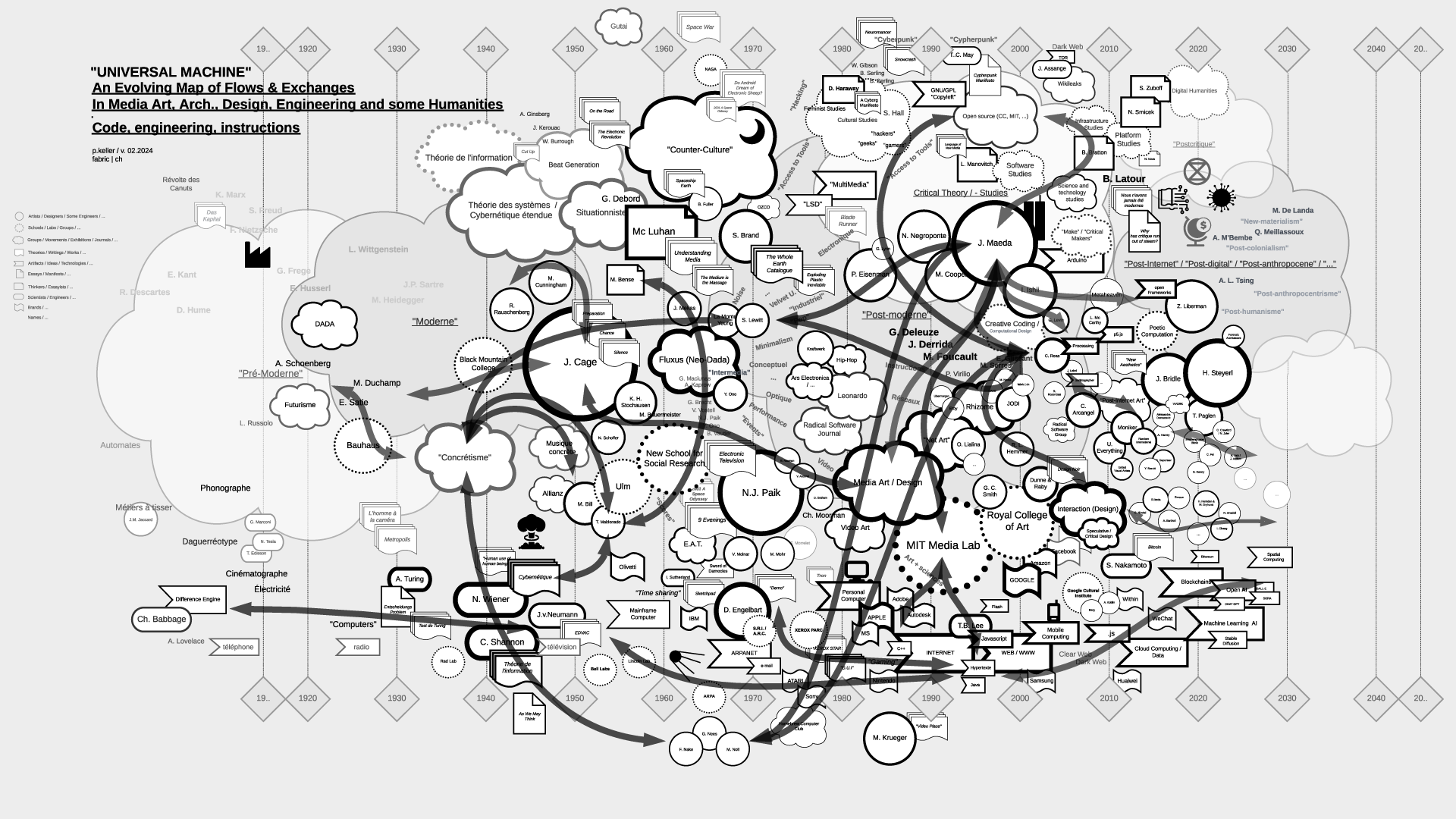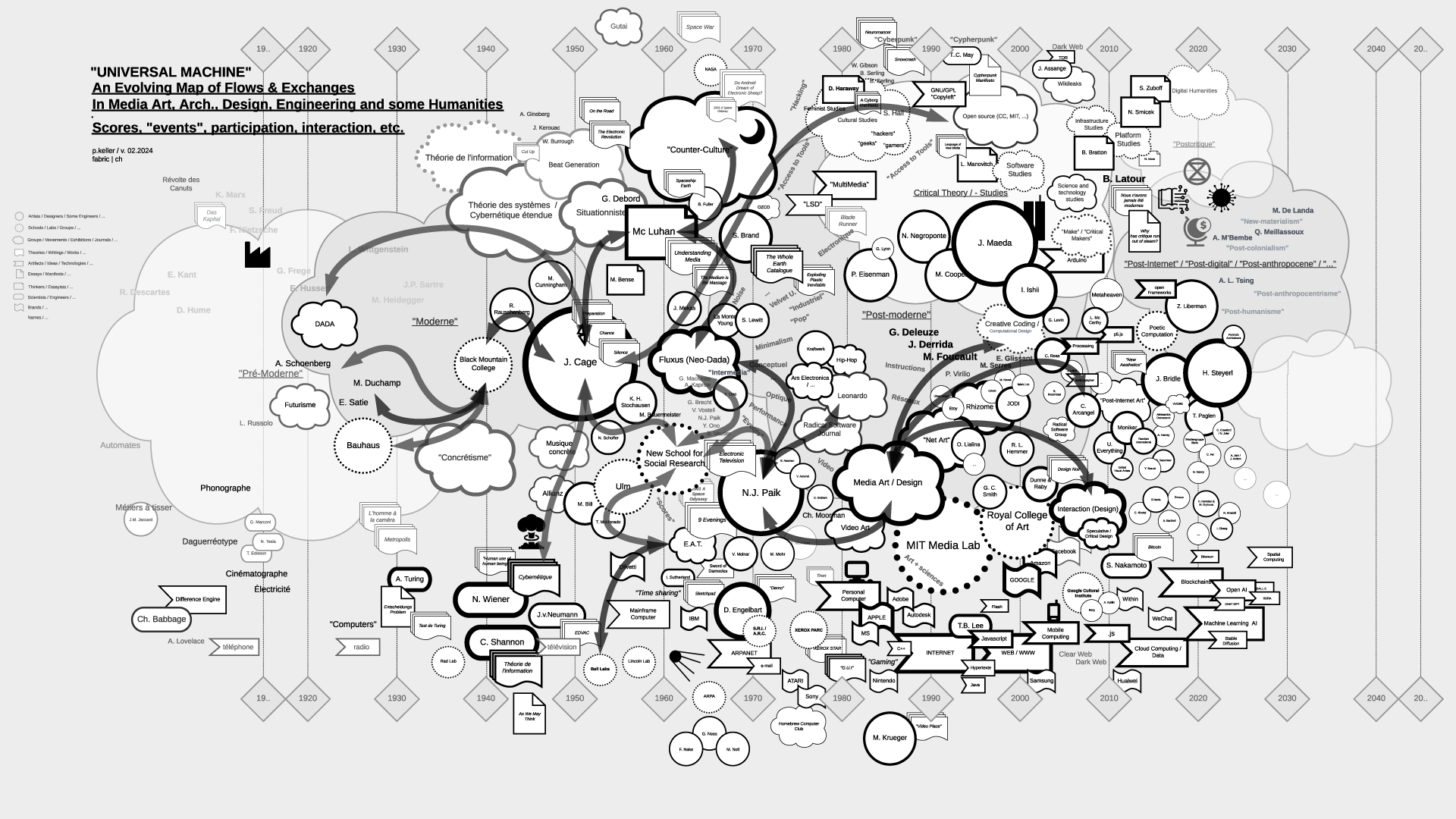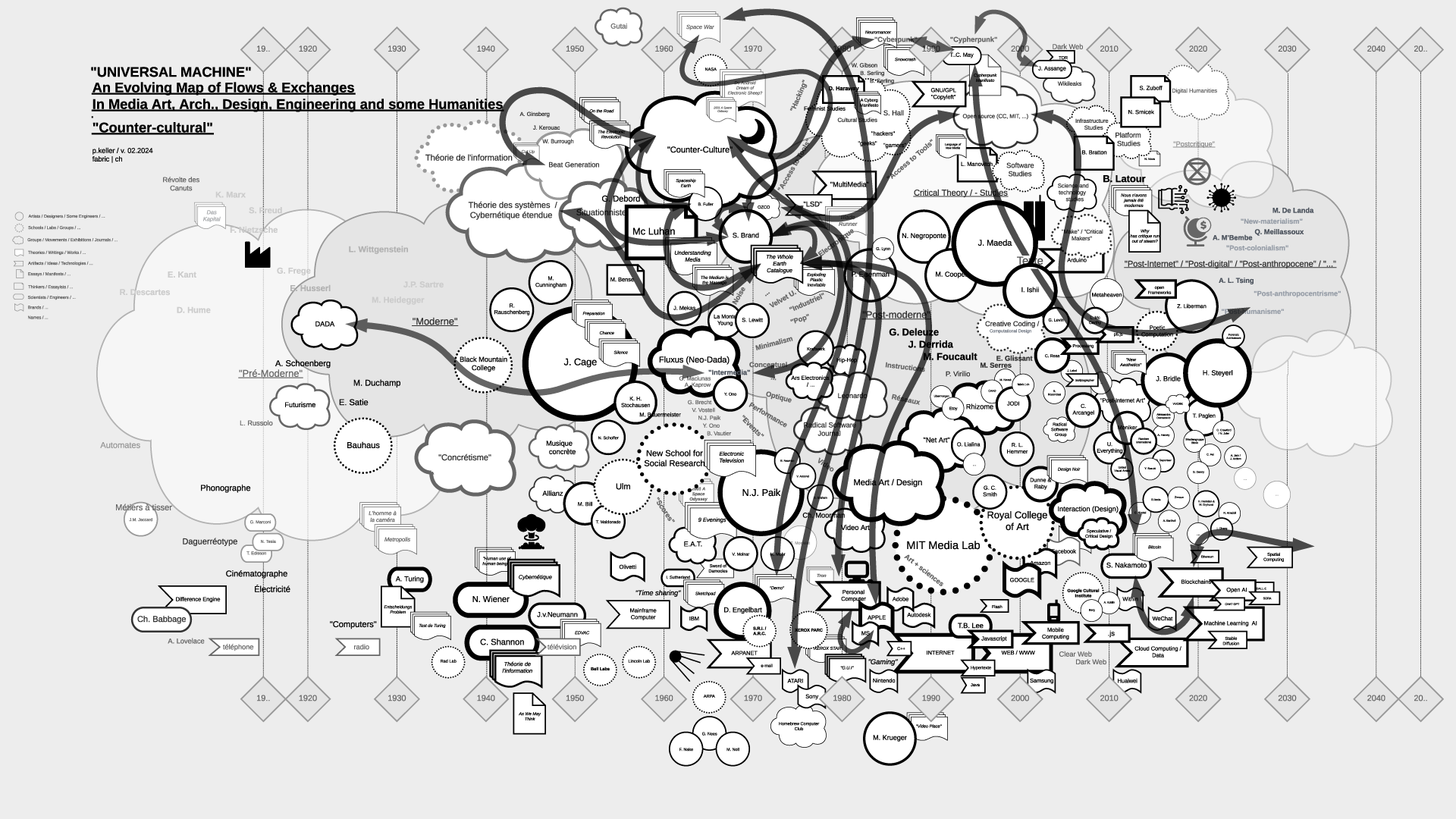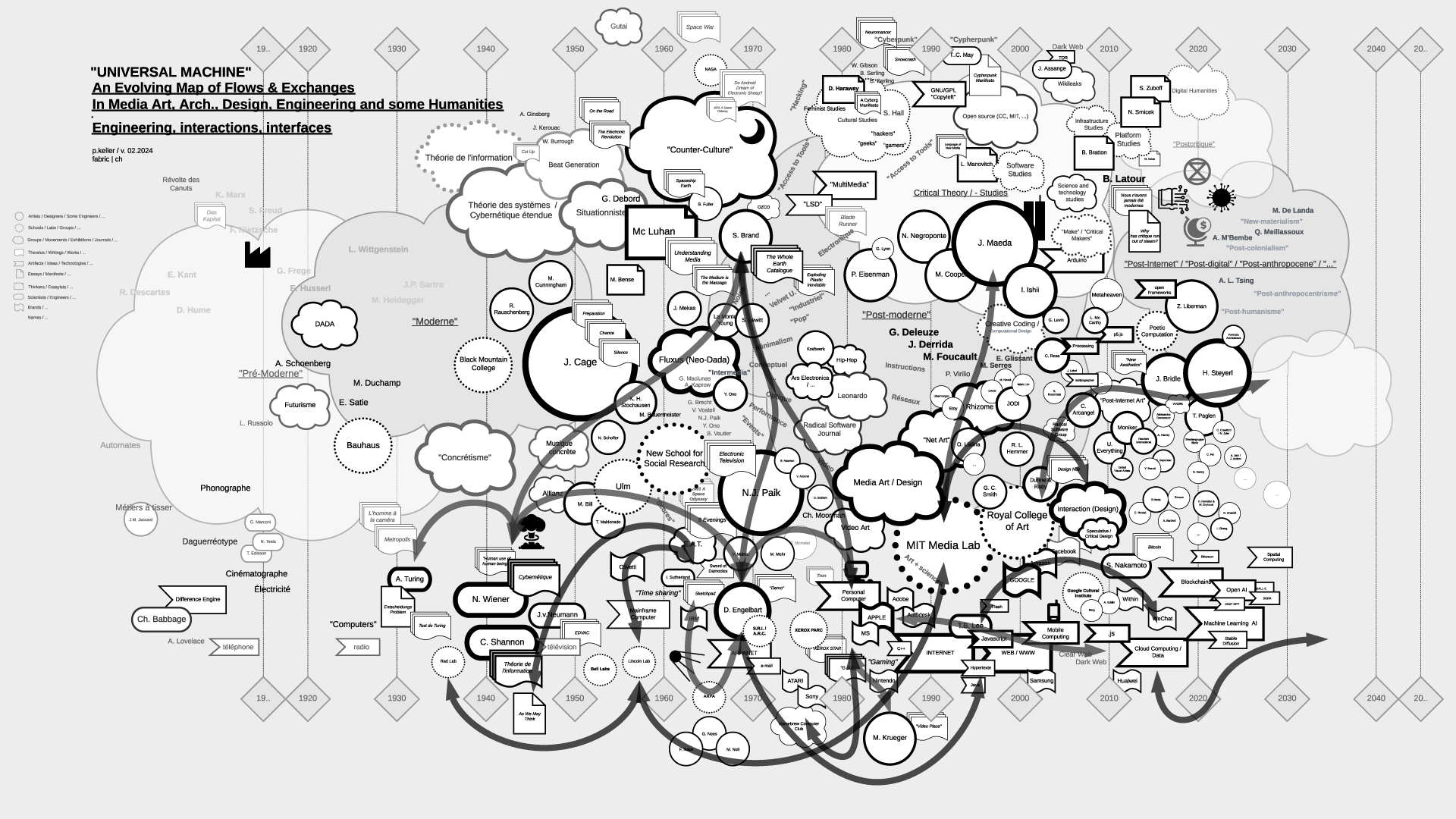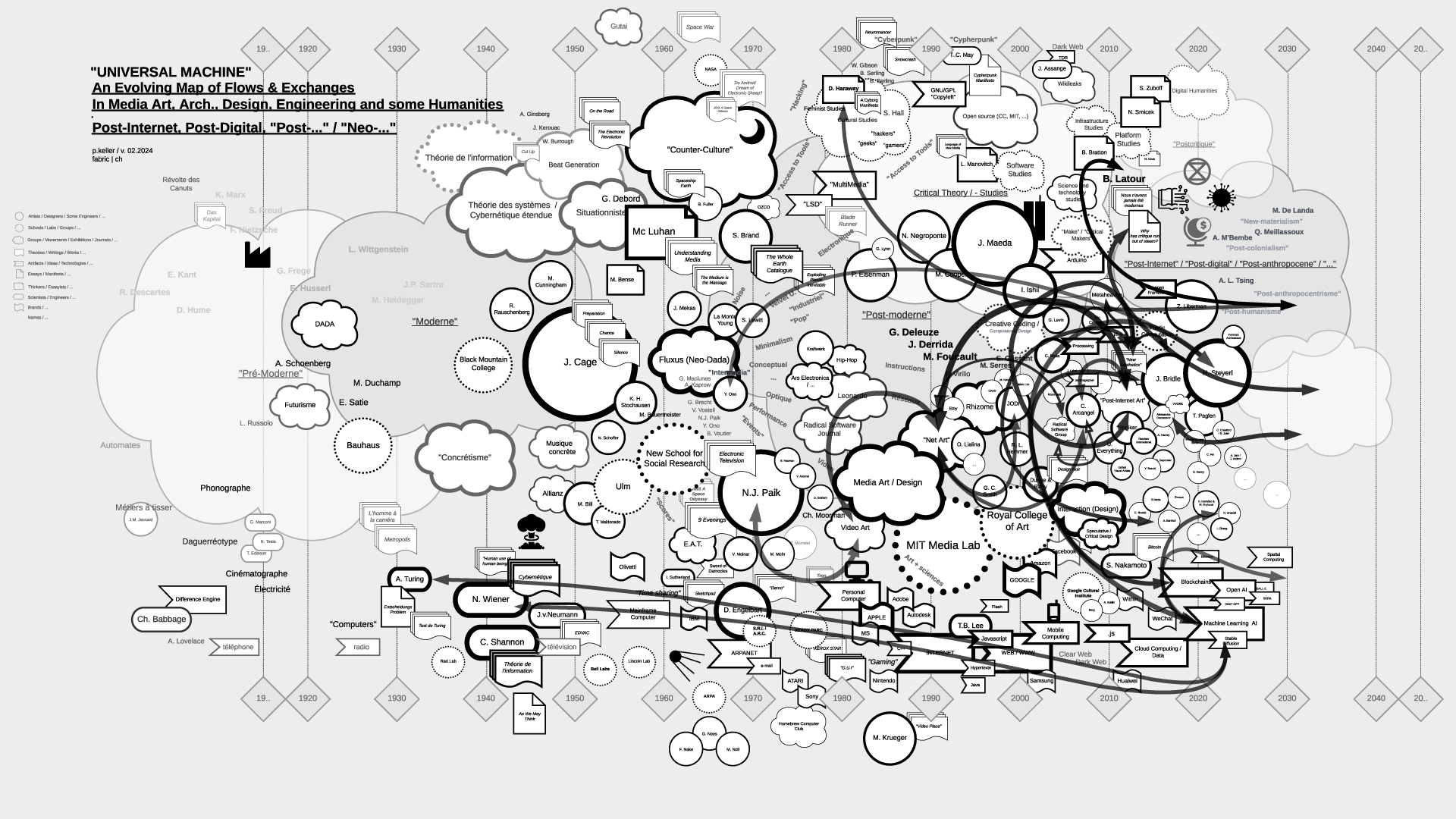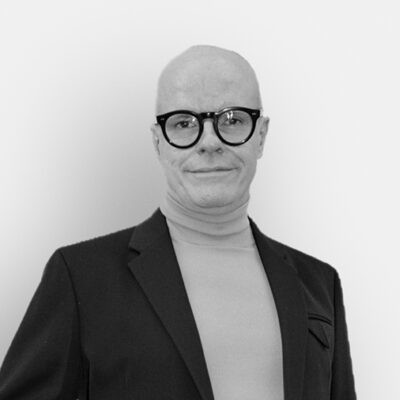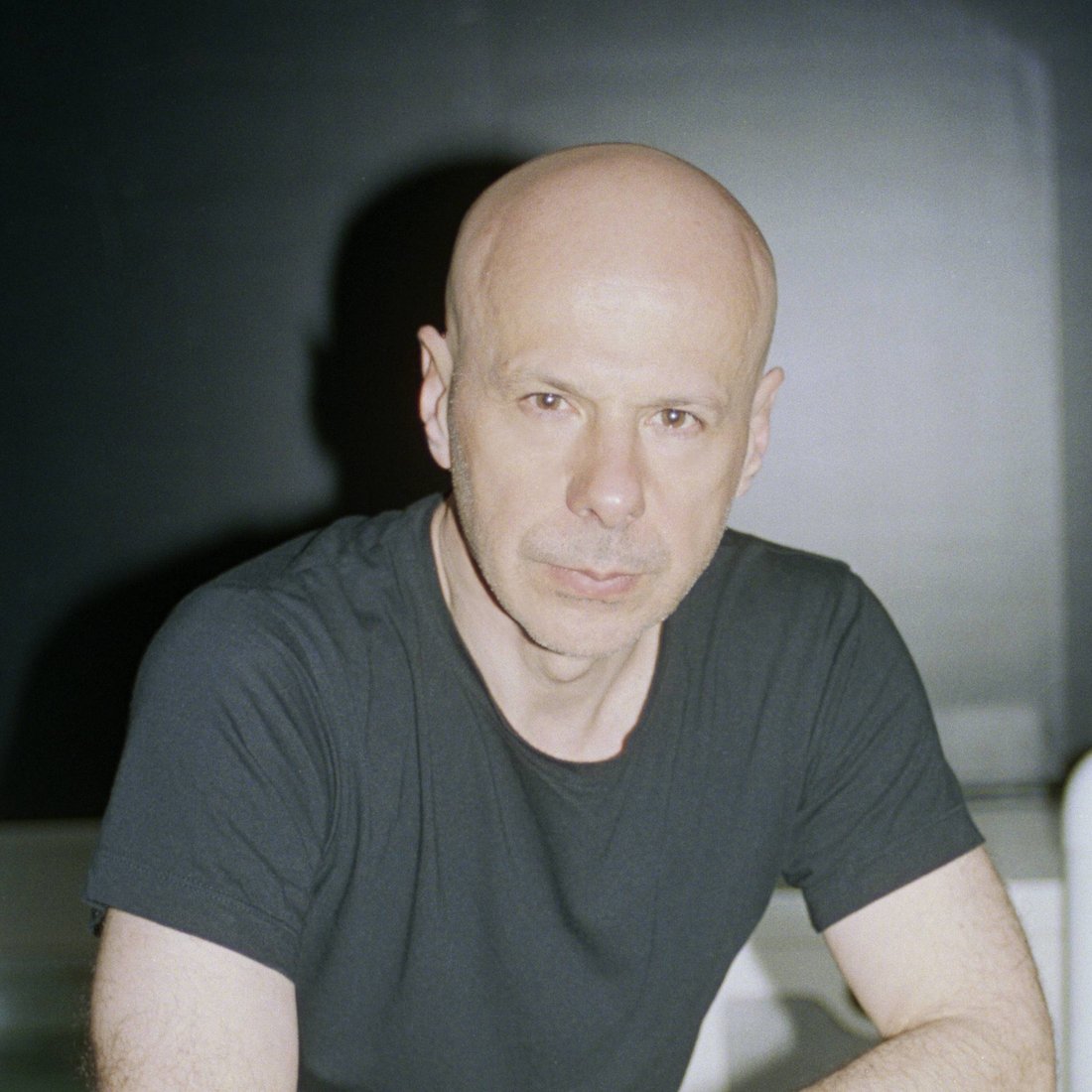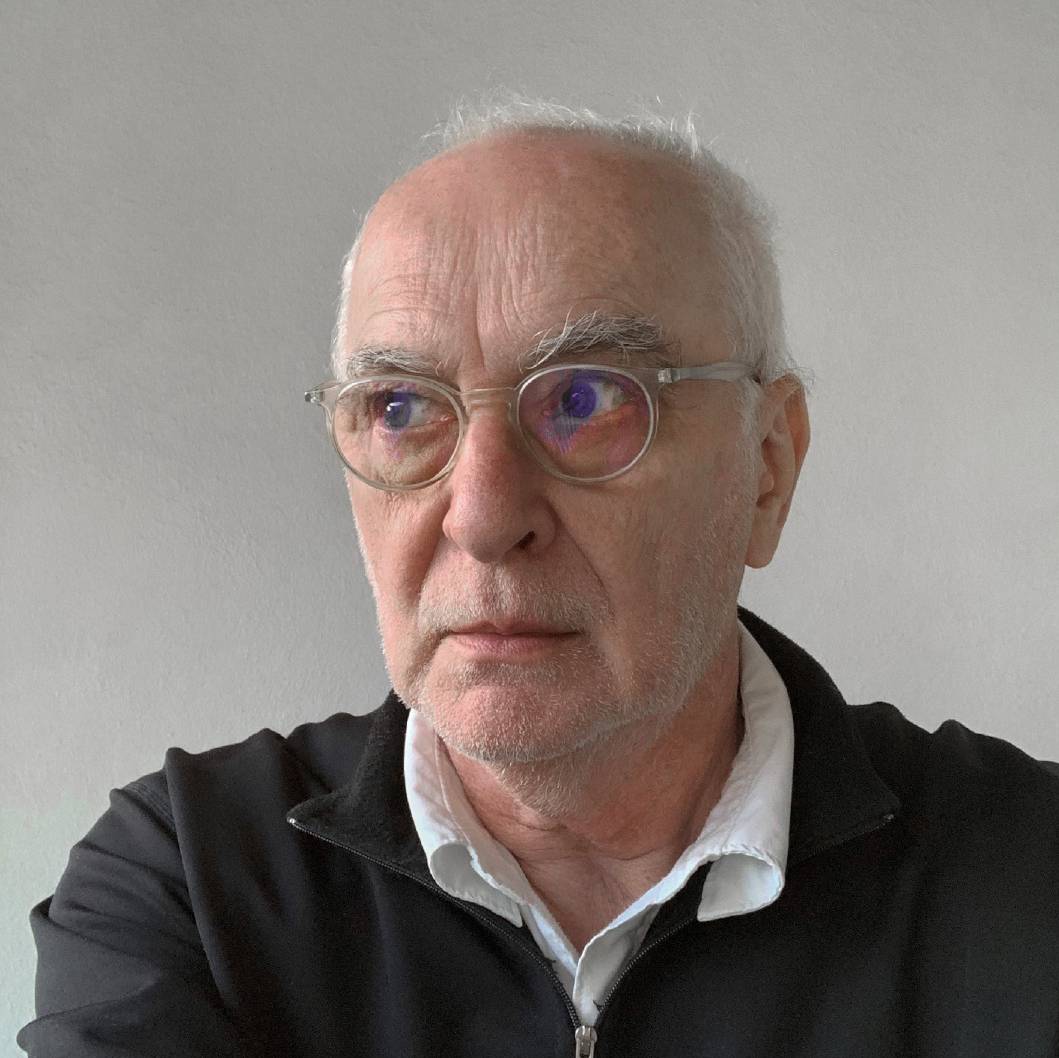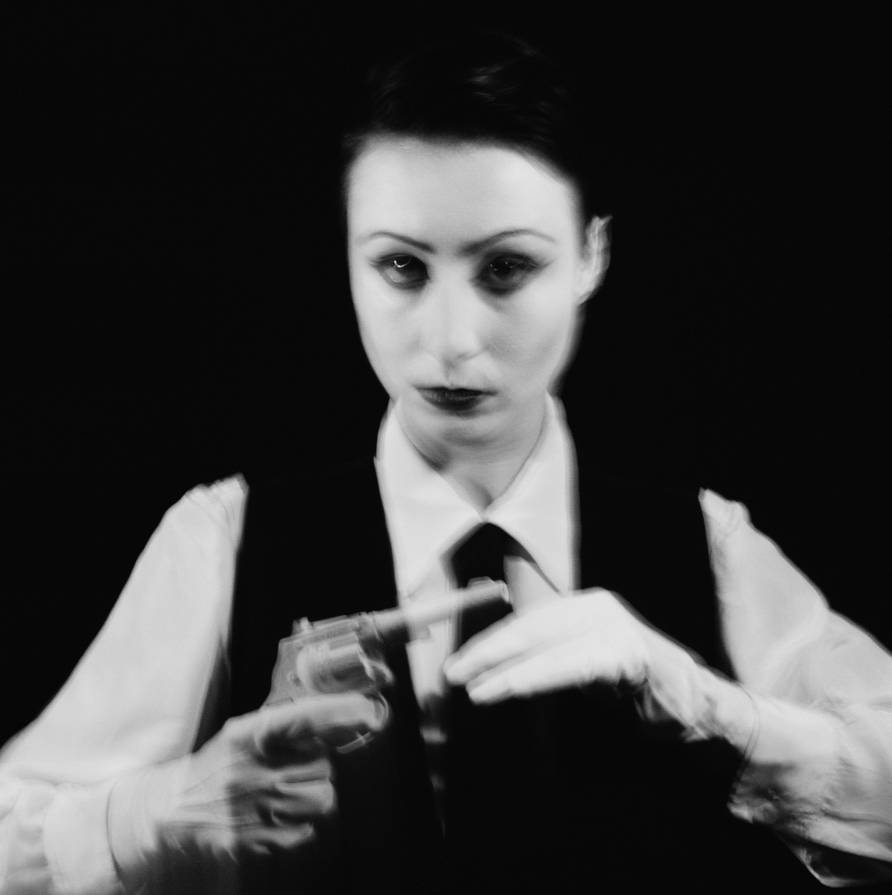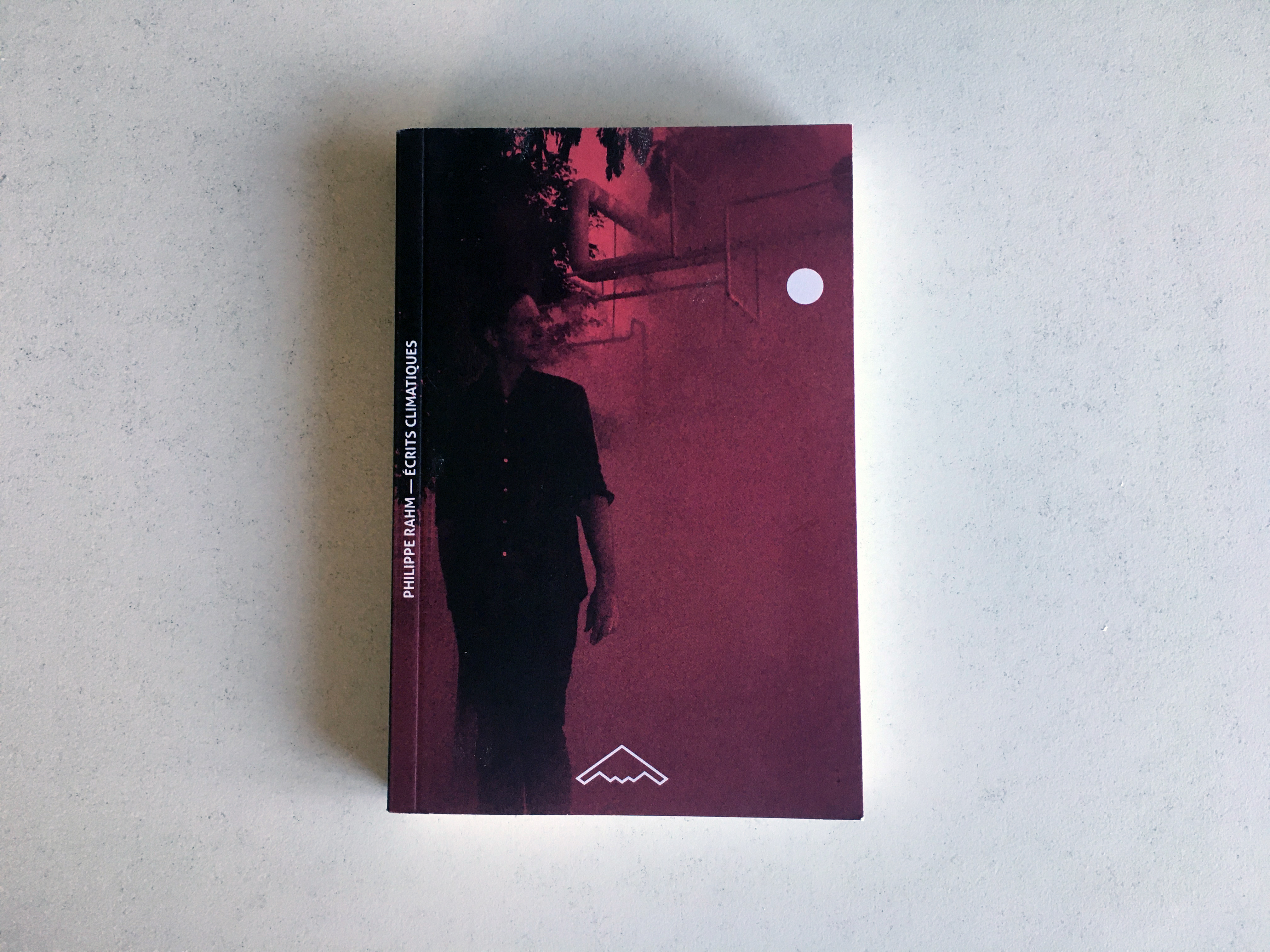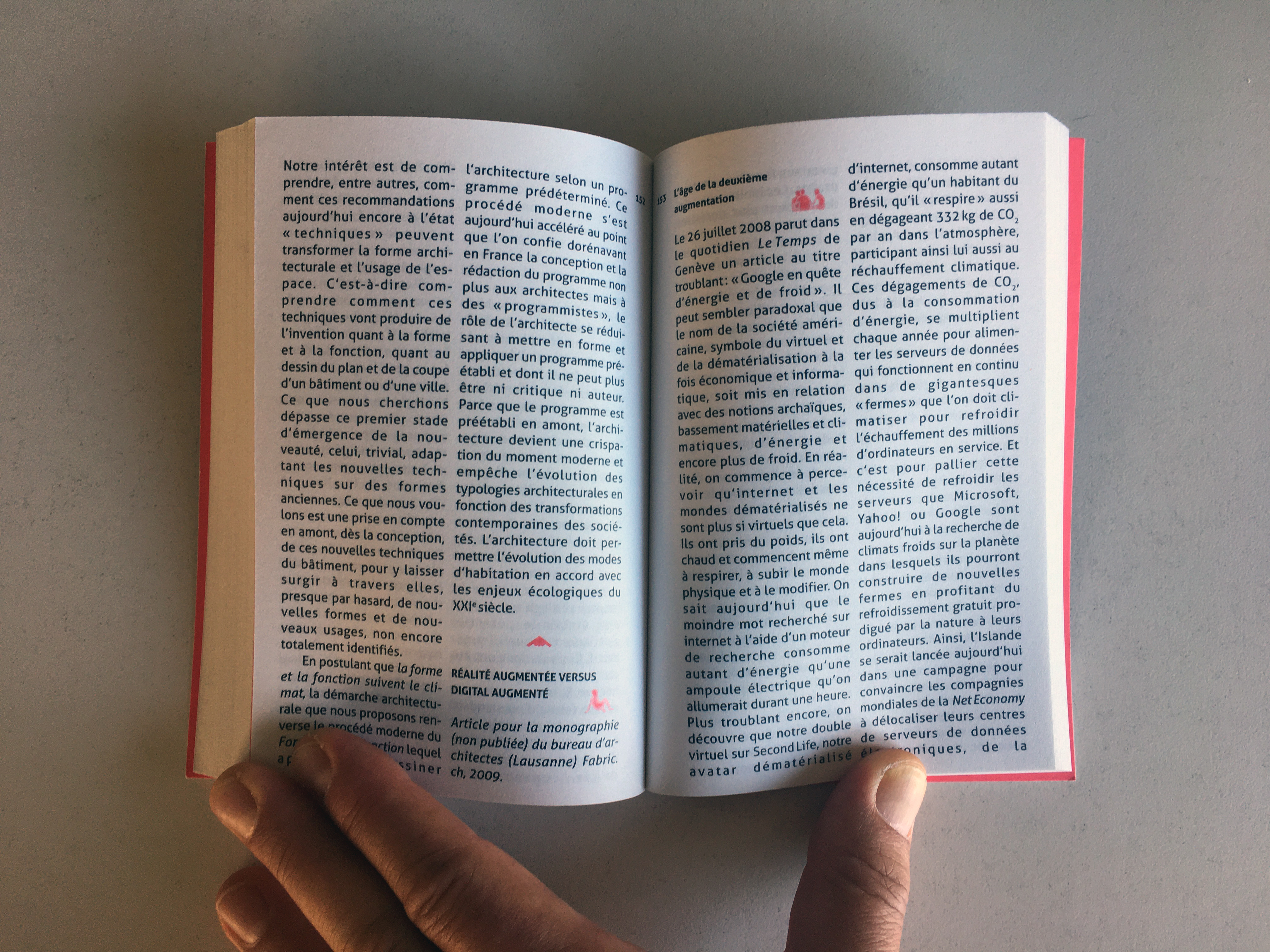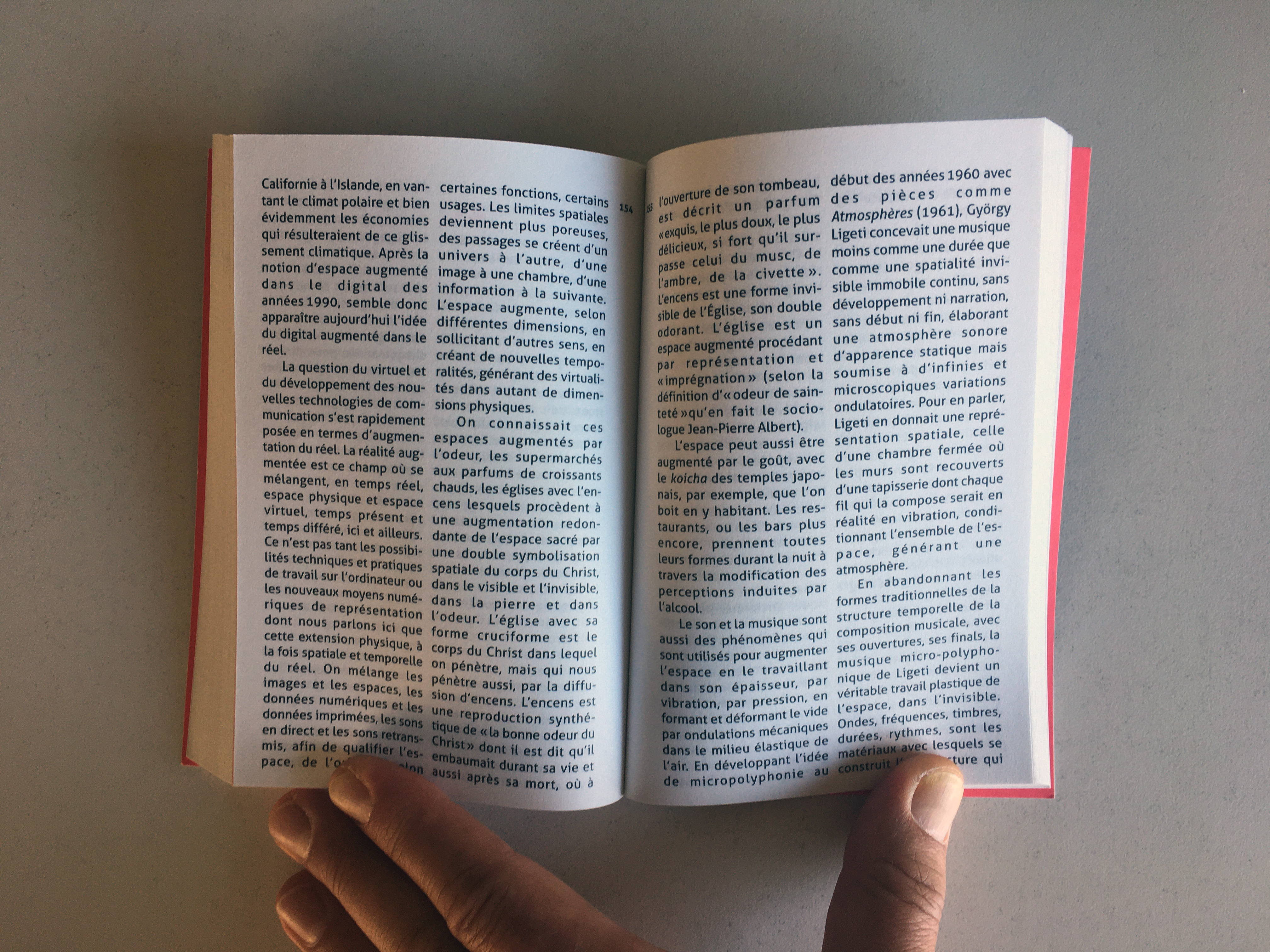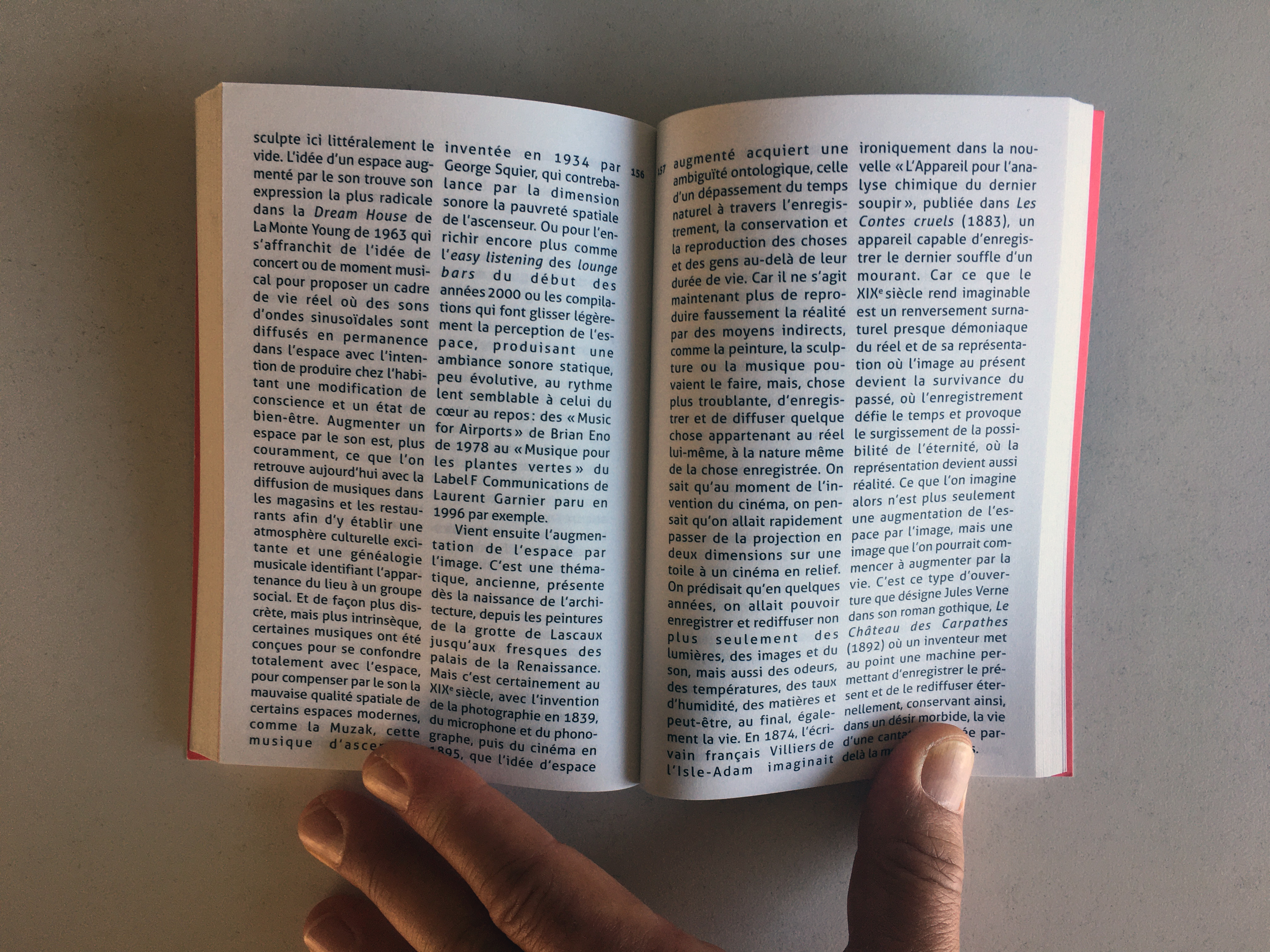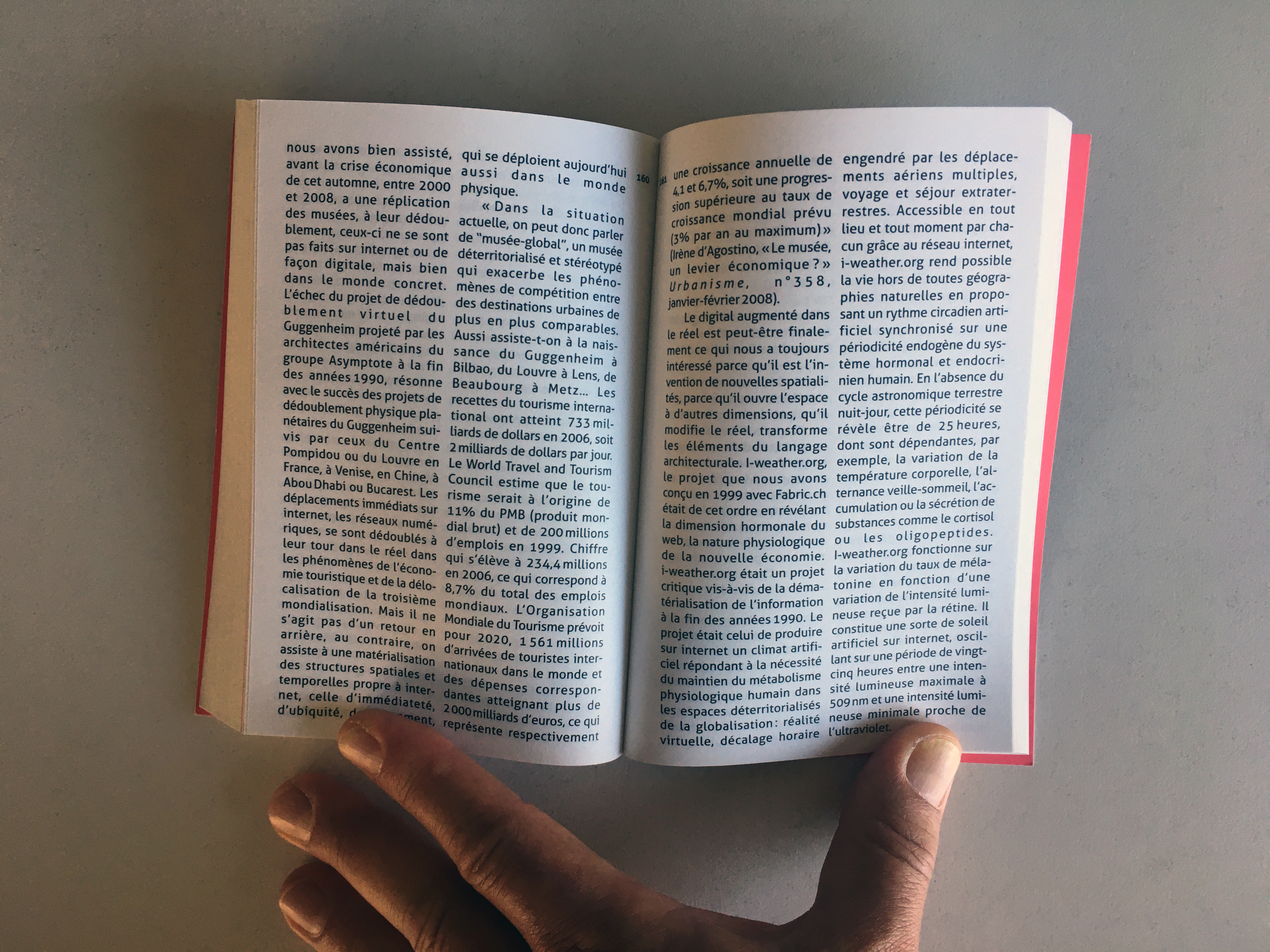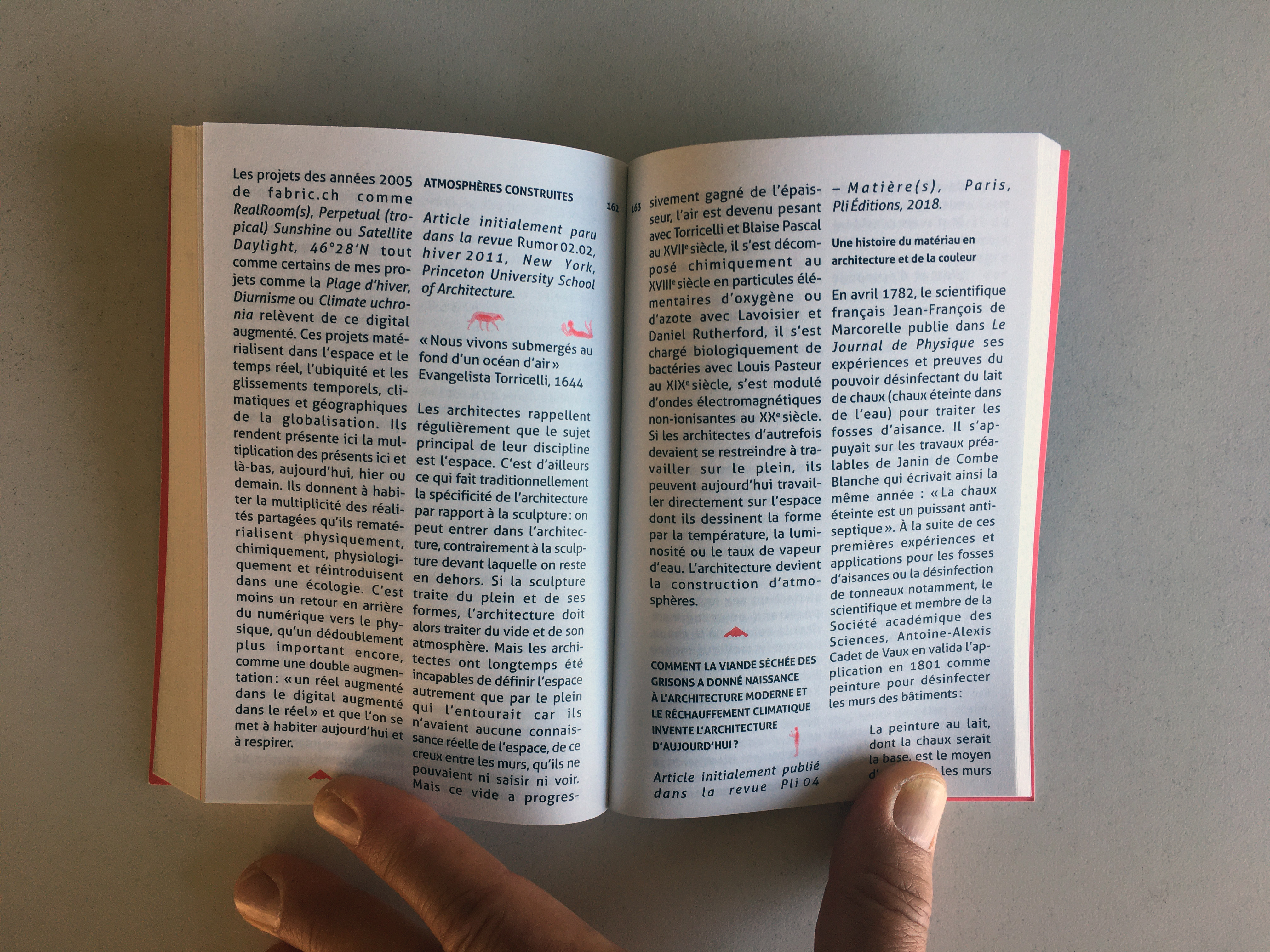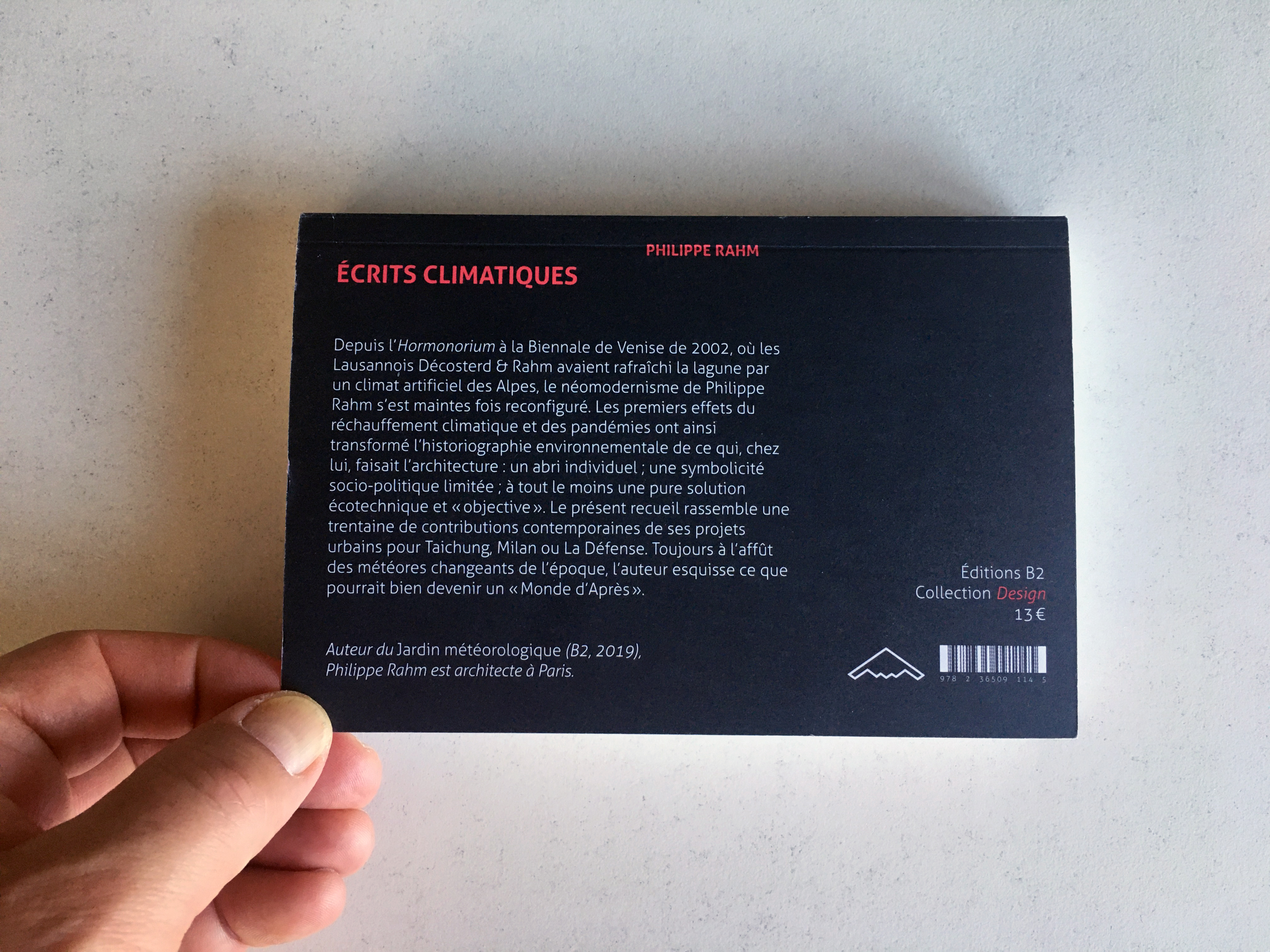Sticky Postings
All 242 fabric | rblg updated tags | #fabric|ch #wandering #reading
By fabric | ch
-----
As we continue to lack a decent search engine on this blog and as we don't use a "tag cloud" ... This post could help navigate through the updated content on | rblg (as of 09.2023), via all its tags!
FIND BELOW ALL THE TAGS THAT CAN BE USED TO NAVIGATE IN THE CONTENTS OF | RBLG BLOG:
(to be seen just below if you're navigating on the blog's html pages or here for rss readers)
--
Note that we had to hit the "pause" button on our reblogging activities a while ago (mainly because we ran out of time, but also because we received complaints from a major image stock company about some images that were displayed on | rblg, an activity that we felt was still "fair use" - we've never made any money or advertised on this site).
Nevertheless, we continue to publish from time to time information on the activities of fabric | ch, or content directly related to its work (documentation).
Wednesday, March 12. 2025
Summoning the Ghosts of Modernity at MAMM (Medellin) | #exhibition #digital #algorithmic #matter #nonmatter
Note: fabric | ch is part of the exhibition Summoning the Ghosts of Modernity at the Museo de Arte Moderno de Medellin (MAMM), in Colombia.
The show constitutes a continuation of Beyond Matter that took place at the ZKM in 2022/23, and is curated by Lívia Nolasco-Rószás and Esteban Guttiérez Jiménez.
The exhibition will be open between the 13th of March and 15th of June 2025.
-----
By fabric | ch

Atomized (re-)Staging (2022), by fabric | ch. Exhibited during Summing the Ghosts of Modernity at the Museo de Arte Moderno de Medellin (MAMM). March 13 to June 15 2025.
More pictures of the exhibtion on Pixelfed.
Tuesday, February 27. 2024
"Universal Machine": historical graphs on the relations and fluxes between art, architecture, design, and technology (19.. - 20..) | #art&sciences #history #graphs
Note (03.2024): The contents of the files (maps) have been updated as of 02.2024.
-
Note (07.2021): As part of my teaching at ECAL / University of Art and Design Lausanne (HES-SO), I've delved into the historical ties between art and science. This ongoing exploration focuses on the connection between creative processes in art, architecture, and design, and the information sciences, particularly the computer, also known as the "Universal Machine" as coined by A. Turing. This informs the title of the graphs below and this post.
Through my work at fabric | ch, and previously as an assistant at EPFL followed by a professorship at ECAL, to experience first hand some of these massive transformations in society and culture.
Thus, in my theory courses, I've aimed to create "maps" that aid in comprehending, visualizing, and elucidating the flux and timelines of interactions among individuals, artifacts, and disciplines. These maps, imperfect and constrained by size, are continuously evolving and open to interpretation beyond my own. I regularly update them as part of the process.
Yet, in the absence of a comprehensive written, visual, or sensitive history of these techno-cultural phenomena as a whole, these maps serve as valuable approximation tools for grasping the flows and exchanges that either unite or divide them. They offer a starting point for constructing personal knowledge and delving deeper into these subjects.
This is precisely why, despite their inherent fuzziness - or perhaps because of it - I choose to share them on this blog (fabric | rblg), in an informal manner. It's an invitation for other artists, designers, researchers, teachers, students, and so forth, to begin building upon them, to depict different flows, to develop pre-existing or subsequent ideas, or even more intriguingly, to diverge from them. If such advancements occur, I'm keen on featuring them on this platform. Feel free to reach out for suggestions, comments, or to share new developments.
...
It's worth mentioning that the maps are structured horizontally along a linear timeline, spanning from the late 18th century to the mid-21st century, predominantly focusing on the industrial period. Vertically, they are organized around disciplines, with the bottom representing engineering, the middle encompassing art and design, and the top relating to humanities, social events, or movements.
Certainly, one might question this linear timeline, echoing the sentiments of writer B. Latour. What about considering a spiral timeline, for instance? Such a representation would still depict both the past and the future, while also illustrating the historical proximities of topics, connecting past centuries and subjects with our contemporary context in a circular manner. However, for the time being, and while recognizing its limitations, I adhere to the simplicity of the linear approach.
Countless narratives can emerge as inherent properties of the graphs, underscoring that they are not their origins but rather products thereof.
...
The selection of topics (code, scores-instructions, countercultural, network-related, interaction, "post-...") currently aligns with the themes of my teaching but is subject to expansion, possibly toward an underlying layer revealing the material conditions that underpinned and facilitated the entire process.
In any case, this could serve as a fruitful starting point for some further readings or perhaps a new "Where's Waldo/Wally" kind of game!
Via fabric | ch
-----
By Patrick Keller
Rem.: By clicking on the thumbnails below you'll get access to HD versions.
"Universal Machine", main map (late 18th to mid 21st centuries):
Flows in the map > "Code":
Flows in the map > "Scores, Partitions, ...":
Flows in the map > "Countercultural, Subcultural, ...":
Flows in the map > "Network Related":
Flows in the map > "Interaction":
Flows in the map > "Post-Internet/Digital, "Post -..." , "Neo -...", ML/AI":
...
To be continued (& completed) ...
Wednesday, November 29. 2023
Architecture & Landscape Award 2023 from Fondation Vaudoise pour la Culture (FVPC) | #award #fabricch #architecture #interaction #research
Note: fabric | ch was honored to receive this year the Award for Architecture and Landscape Culture from the Fondation vaudoise pour la culture (FVPC).
The price distinguishes an actor who is "involved in the design or promotion of built environment and who, through this commitment, contributes to the quality of our natural, [digital] and built environment".
A brief video portait of fabric | ch was produced on this occasion by director Pierre-Yves Borgeaud, as well as a small publication by Art Director Emmanuel Crivelli and photographic portraits by Matthieu Croizier (see below).
We'd like to thank the foundation and its jury for awarding our studio in 2023!
-----
By fabric | ch
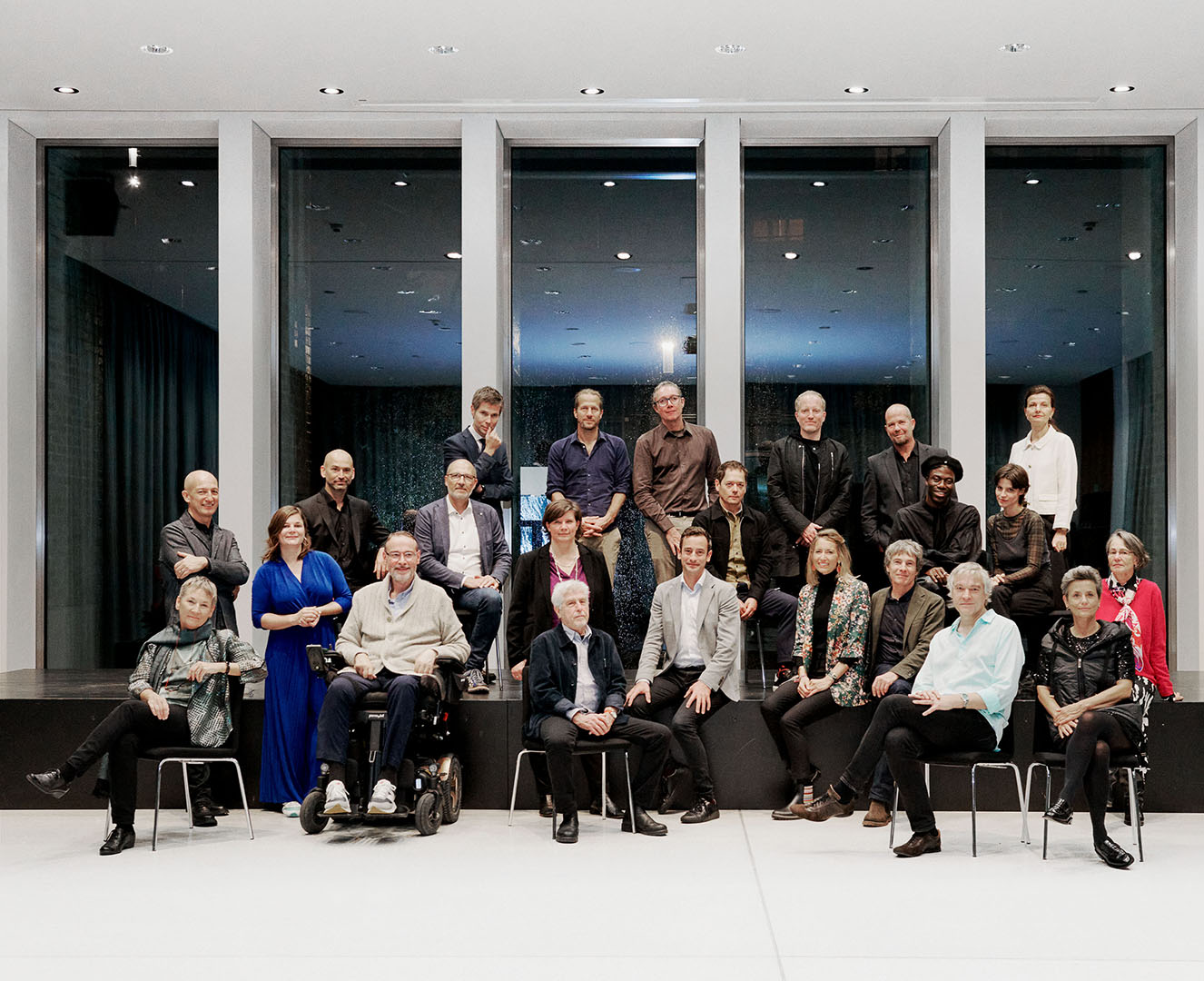
---
---
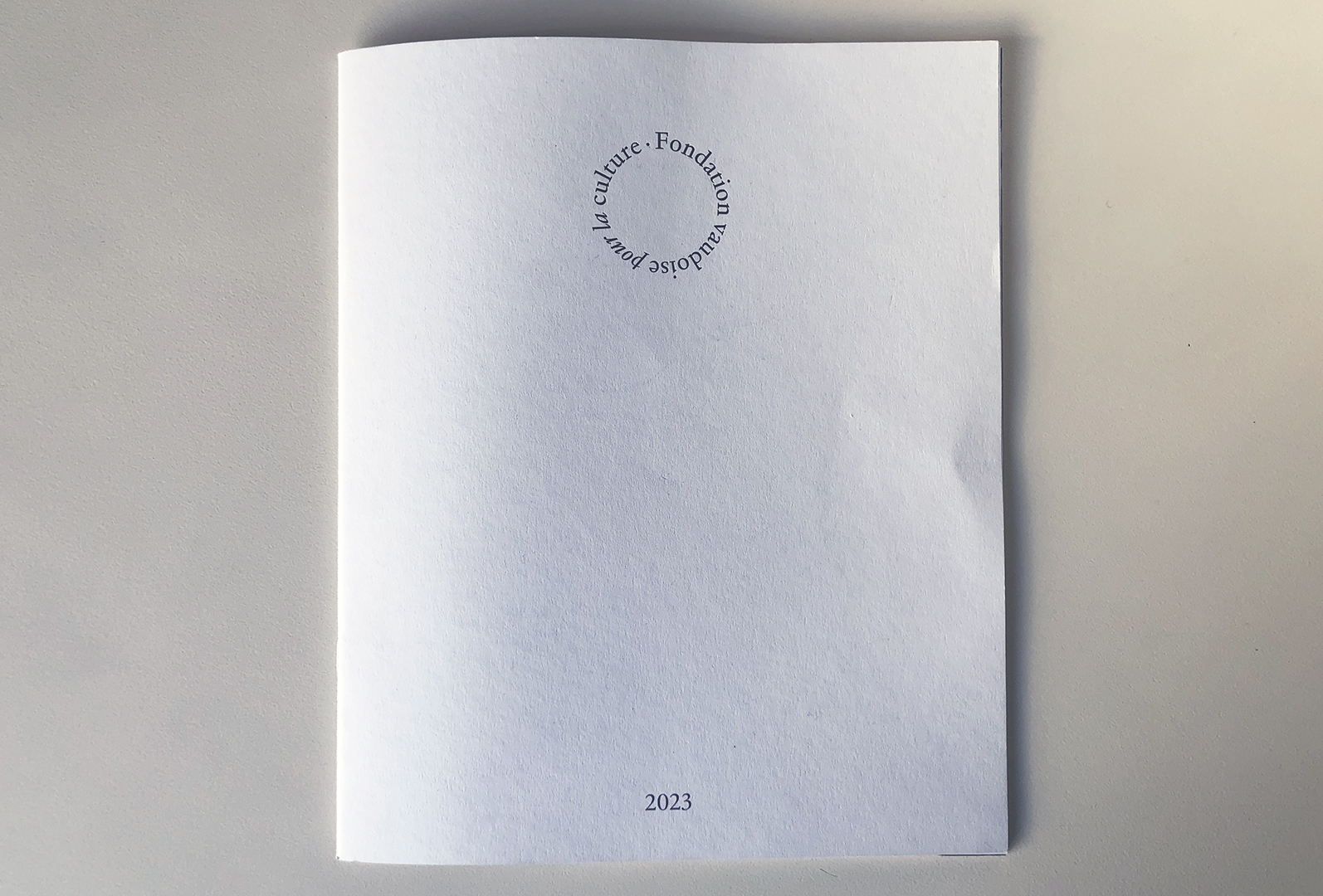
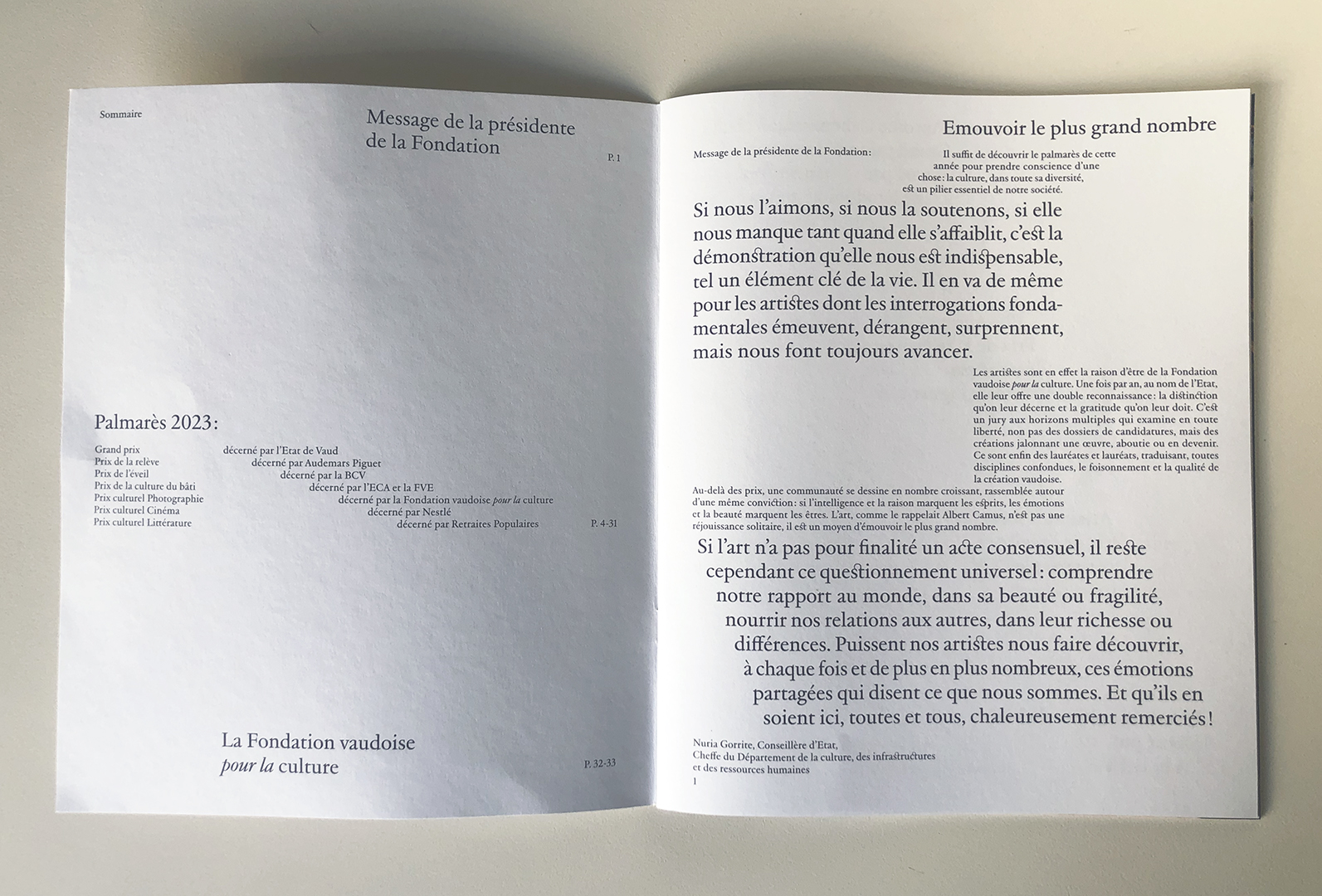
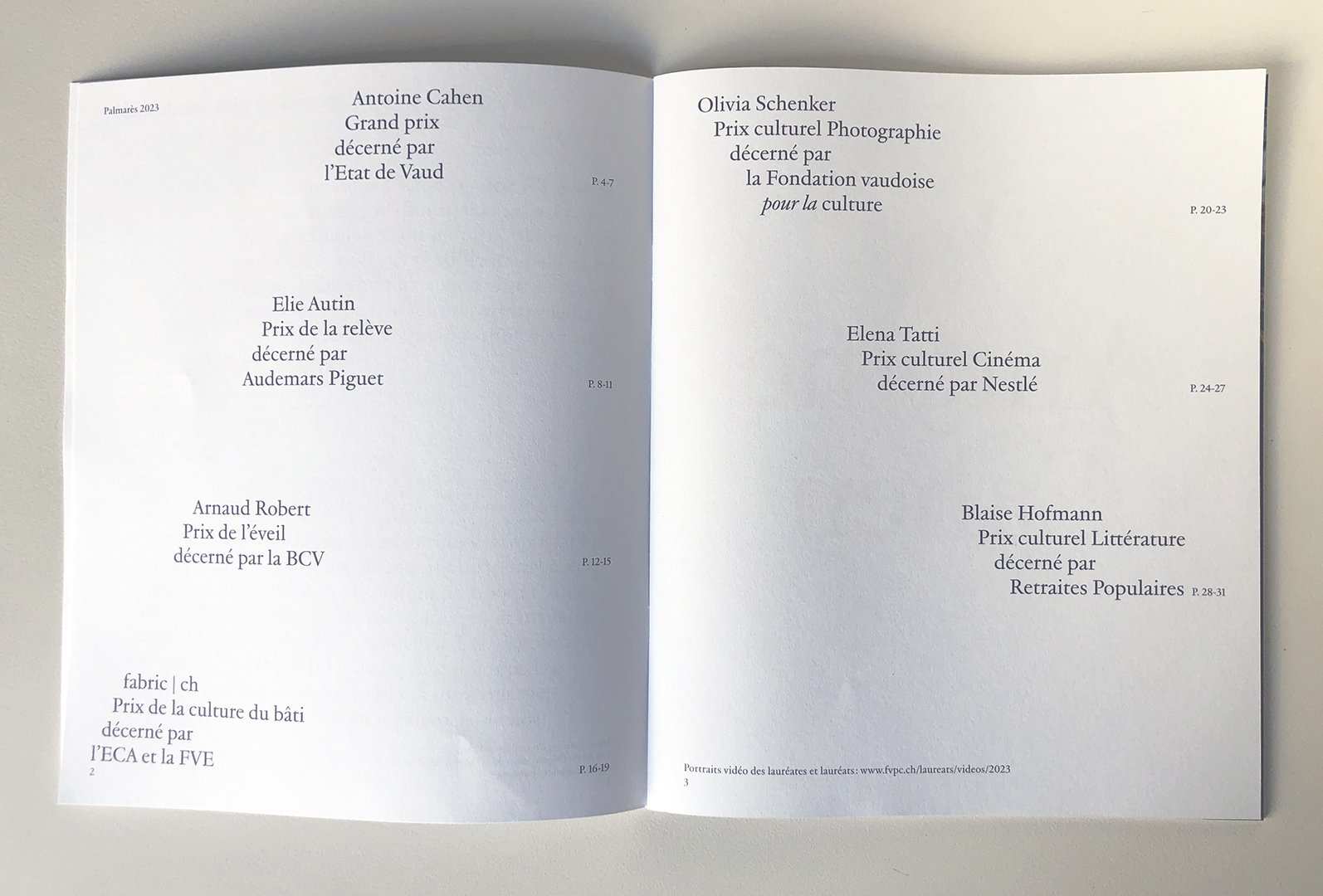
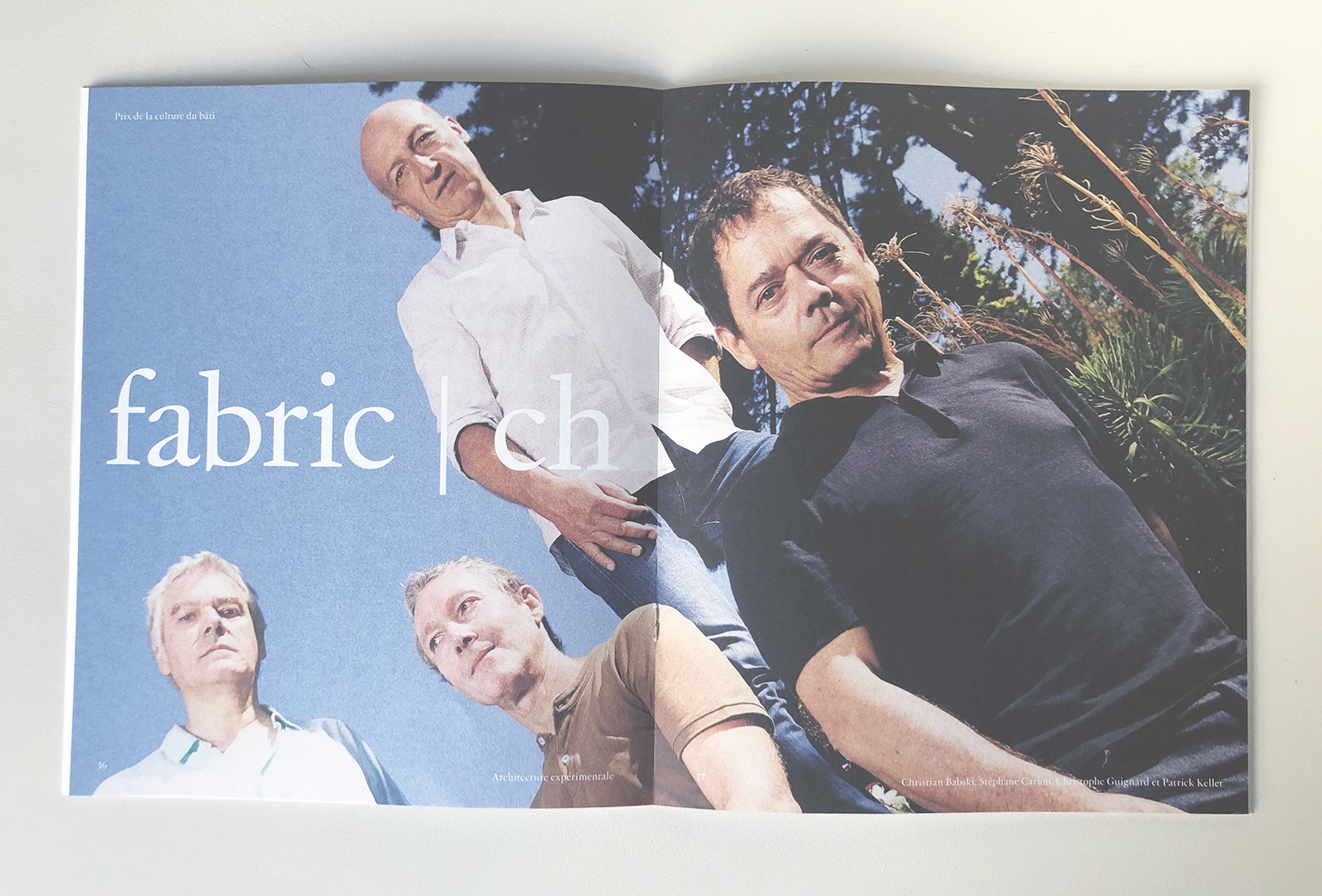
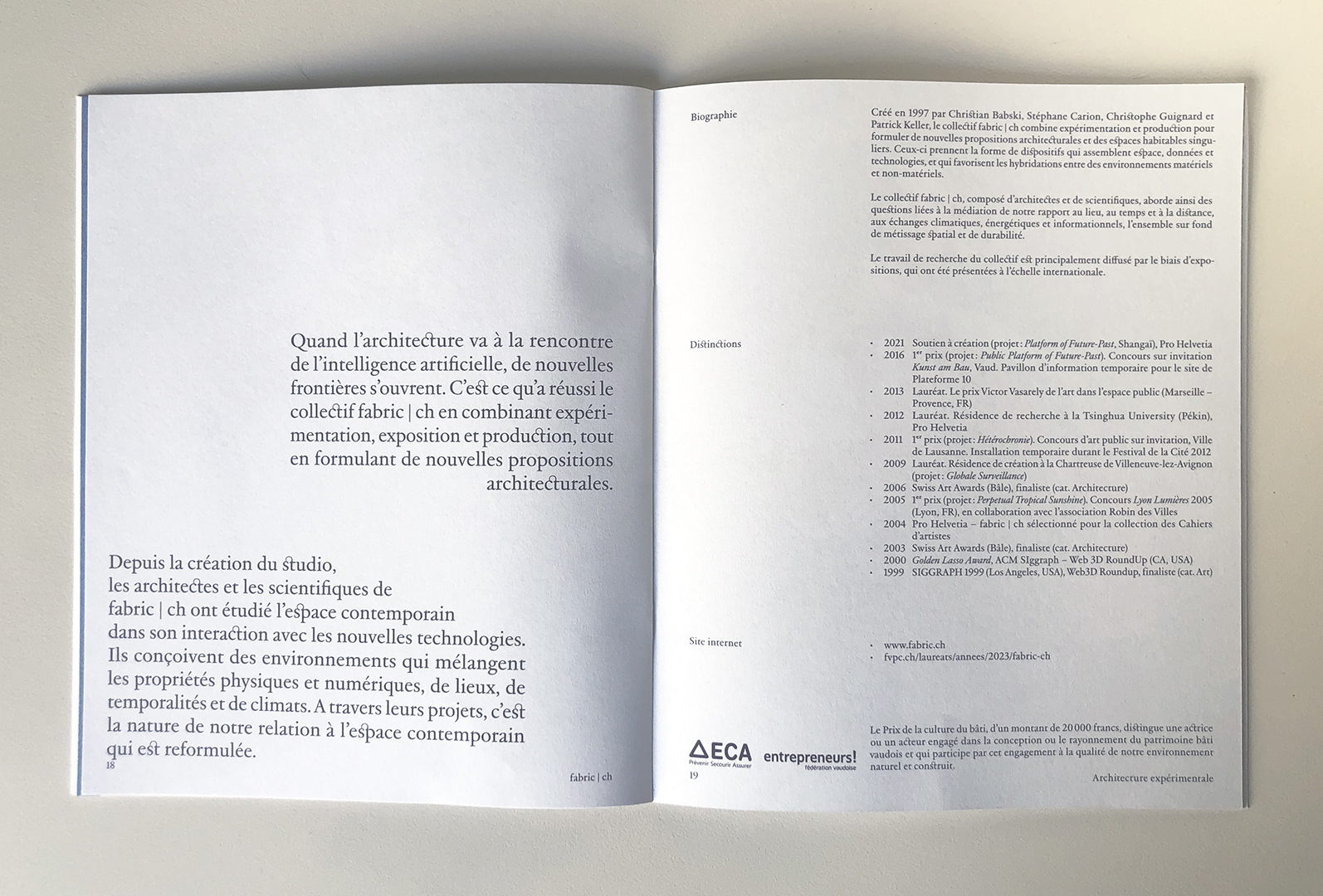
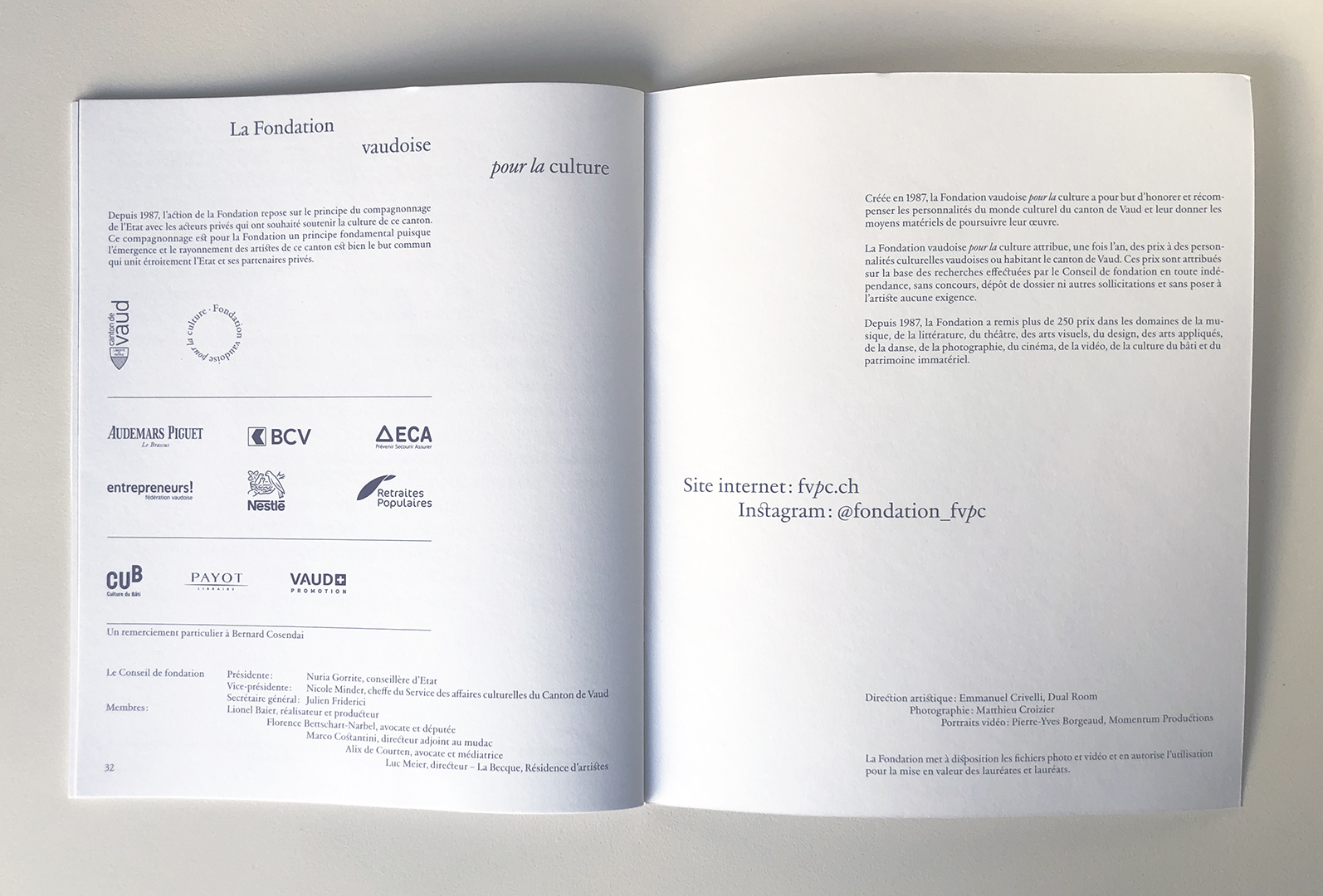

---
... and for the record,
our bit of the award ceremony!
Thursday, August 03. 2023
Moviment exhibition at the Centre Pompidou – fabric | ch during Chapter "Par-delà la matière" | #matter #non-matter #automated #exhibition #fabricch
Note: Early last July, fabric | ch took part in the Moviment exhibition-festival at Centre Pompidou, in Paris.
Organized in 10 chapters (Red thread; The bedroom, the house, the city; In the spotlight; Aloud, Here and elsewhere, Other-worldly; Of gesture and time; To the max; Beyond matter; The grand finale!), this was the occasion – following the words of the curators – to "reactivate the essence of the Centre Pompidou ideals: to assemble all the different ways of encountering creativity, understanding it, participating in it; to be a monument in motion, a "moviment."
It was truly a success, with outstanding guests and a very interesting hybrid museum format, somewhere in-between exhibition and performance, talks and workshops.
In this context and during "Chapitre 9: Par-delà la matière" curated by Marcella Lista & Philippe Bettinelli, fabric | ch presented recent works about digital exhibitions.
-----
By fabric | ch
![]()
A few pictures from Moviment / Chapter 9:
(with fabric | ch, M. Lista & Les Immatériaux, M. Klonaris & K. Thomadaki, H.U. Obrist – "Résistances" project with LUMA Foundation and P. Parreno, J.-L. Boissier - Electra / Pictures by C. Babski & H. Veronese)
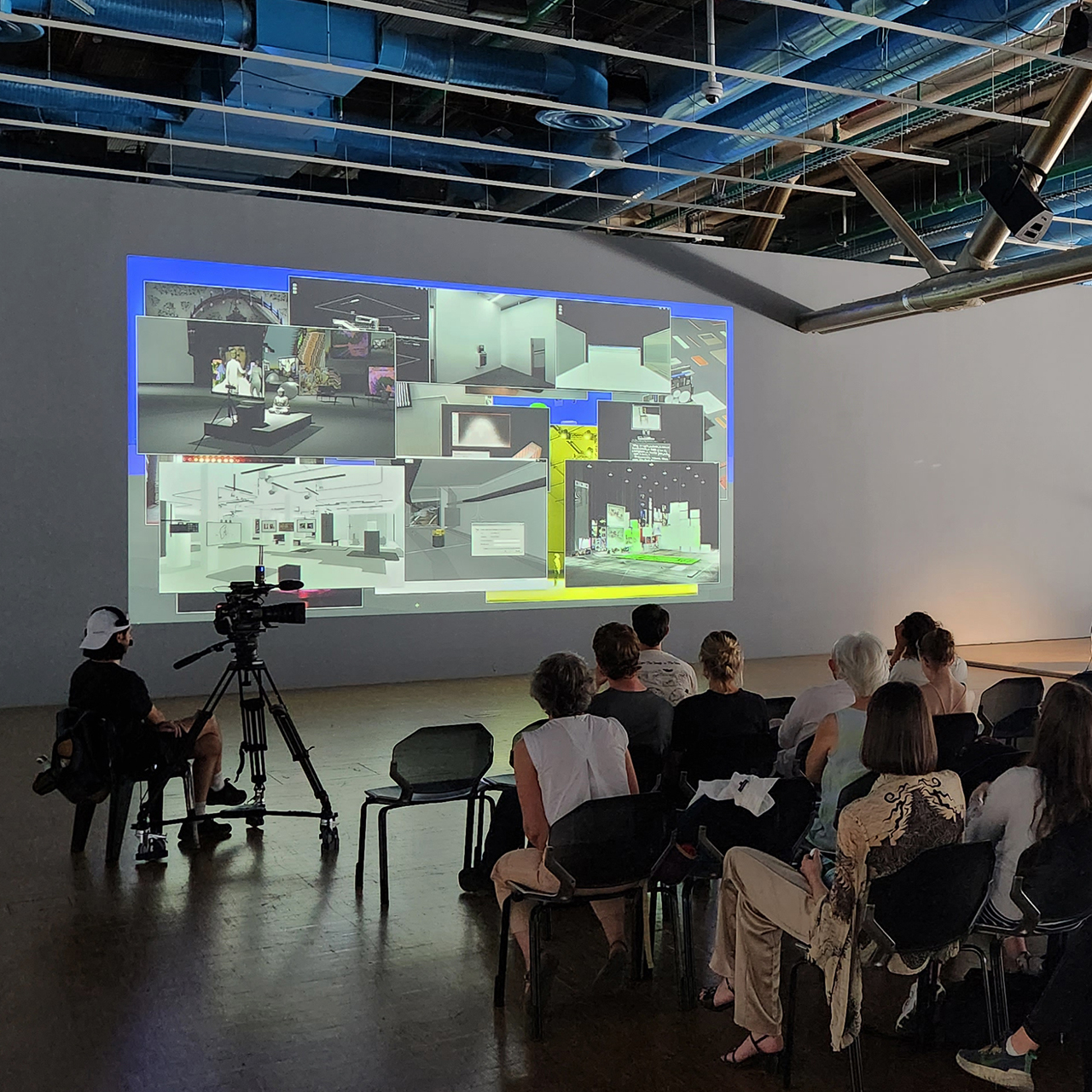
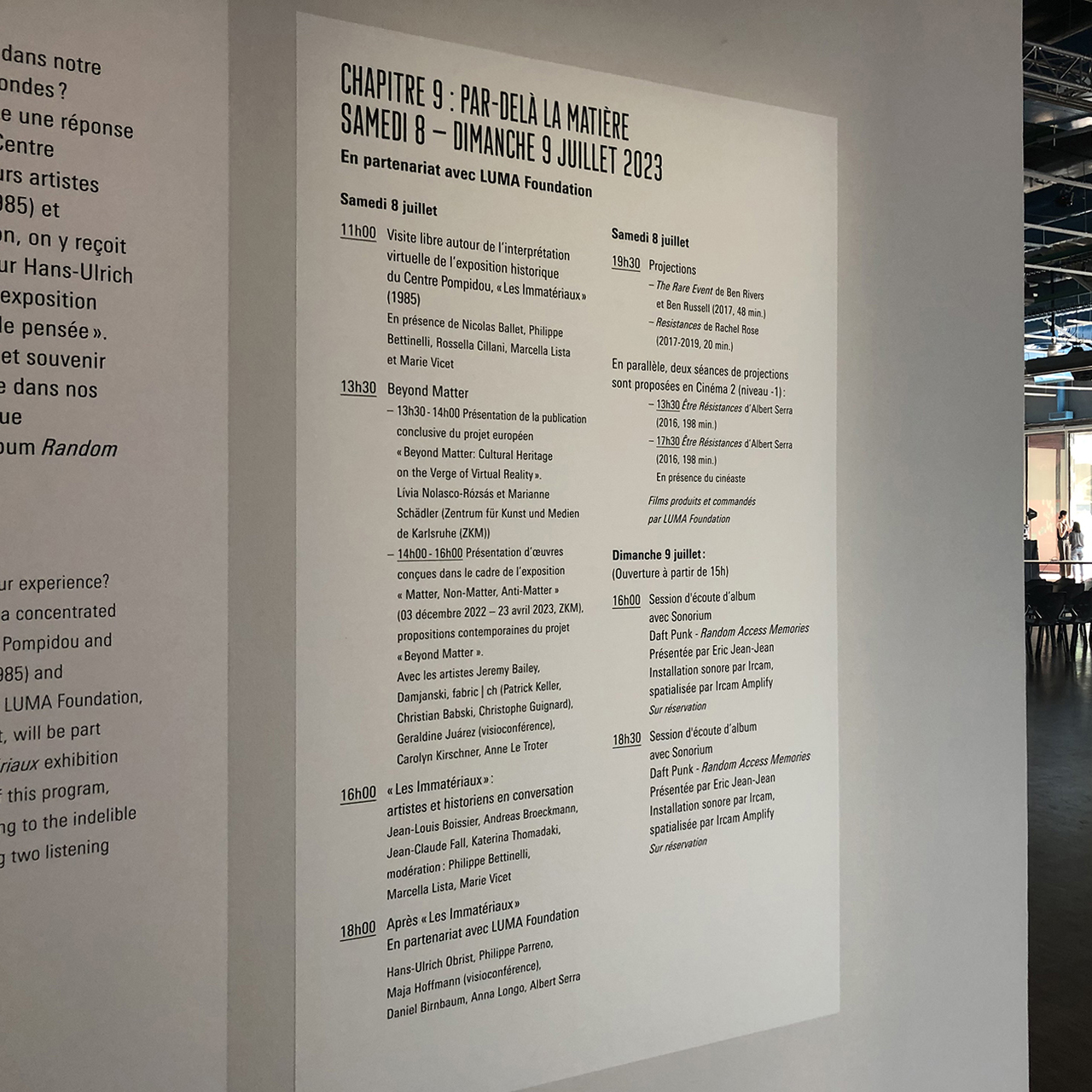
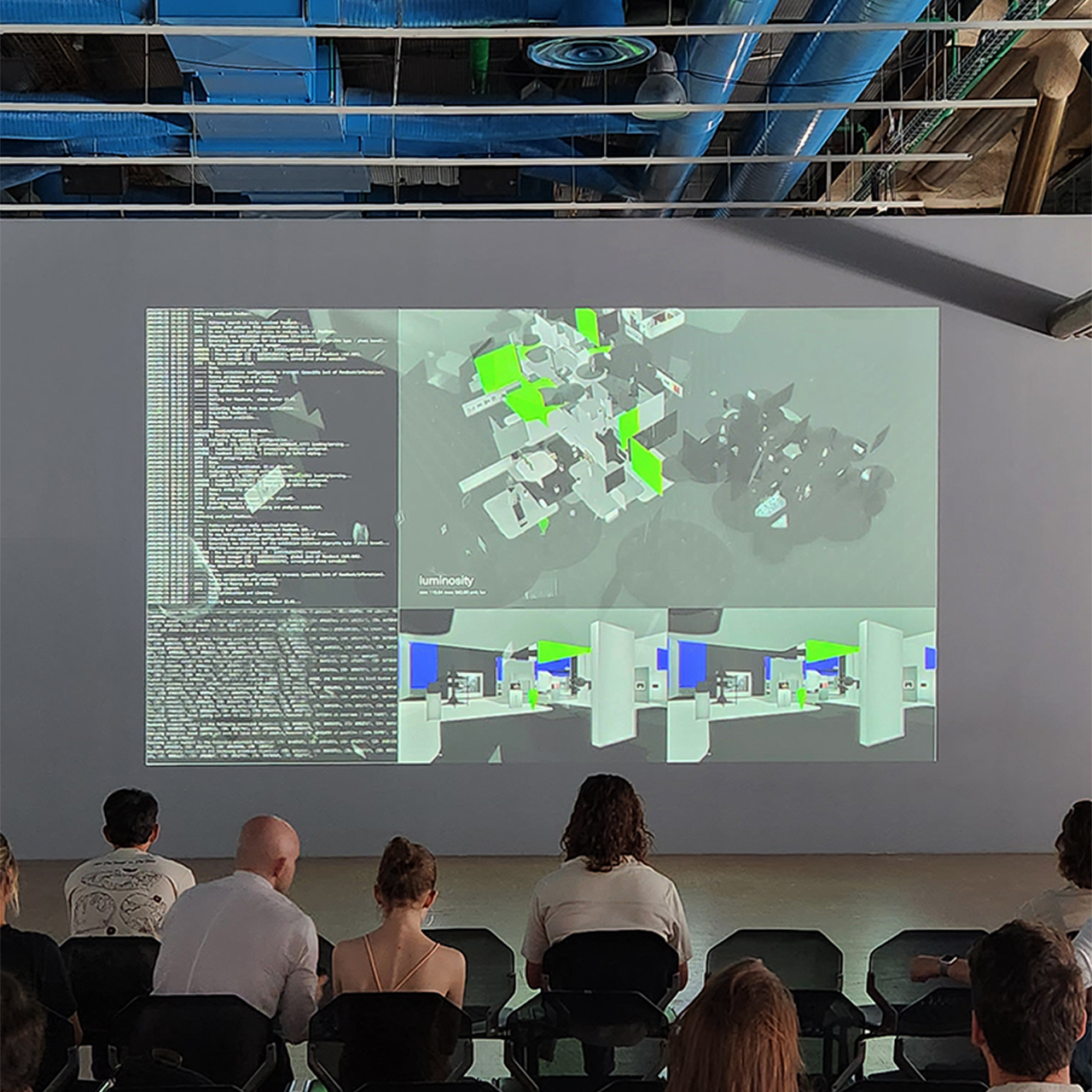
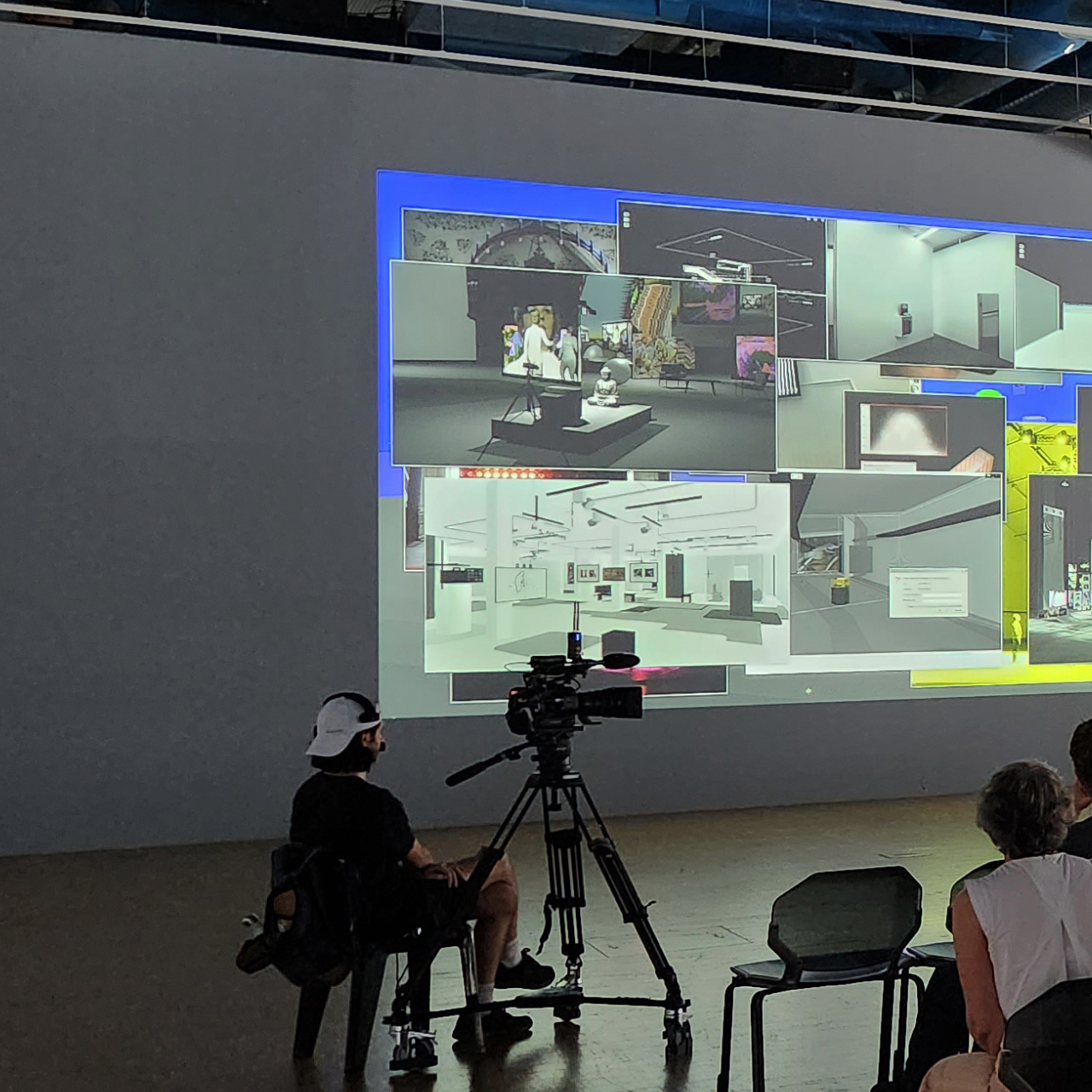
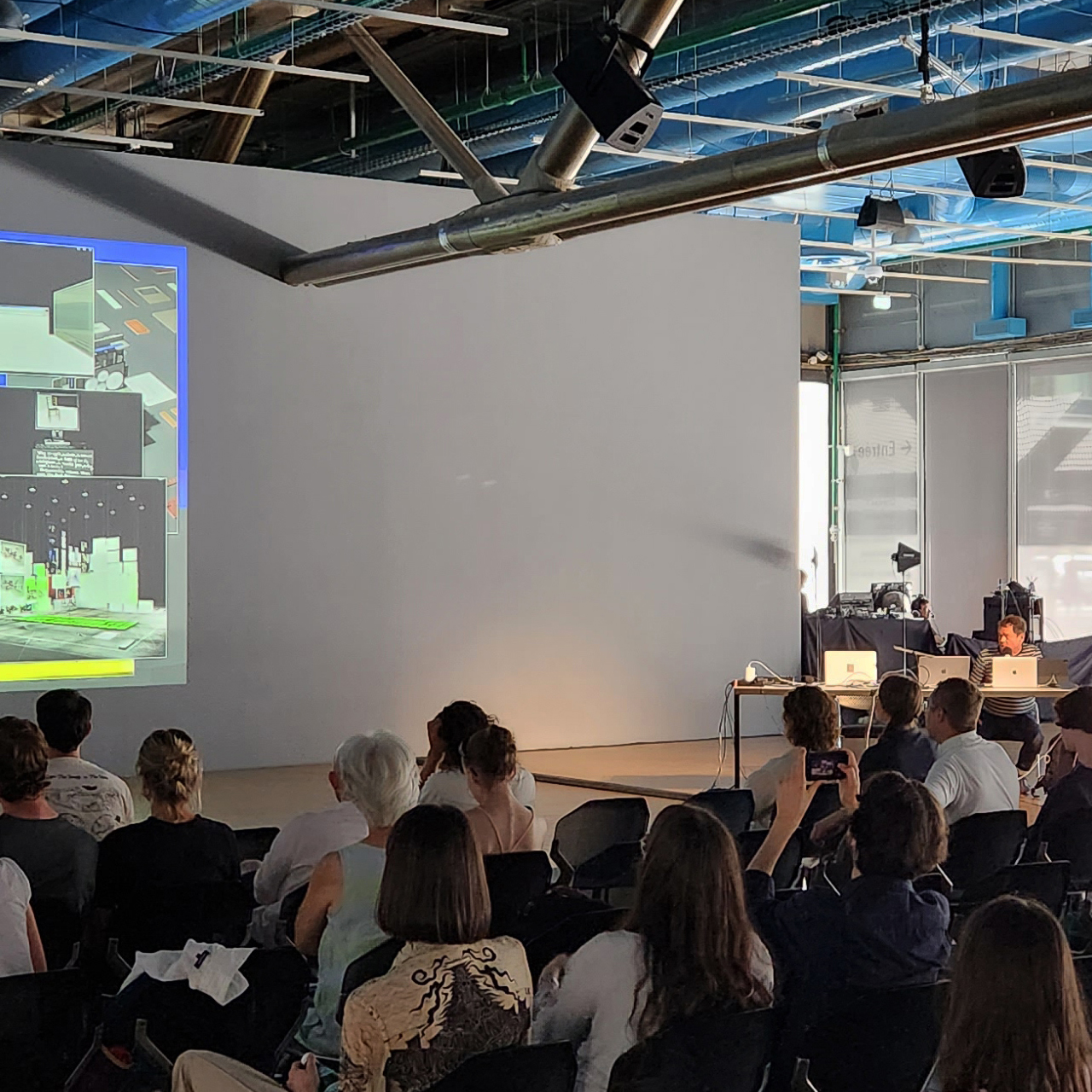
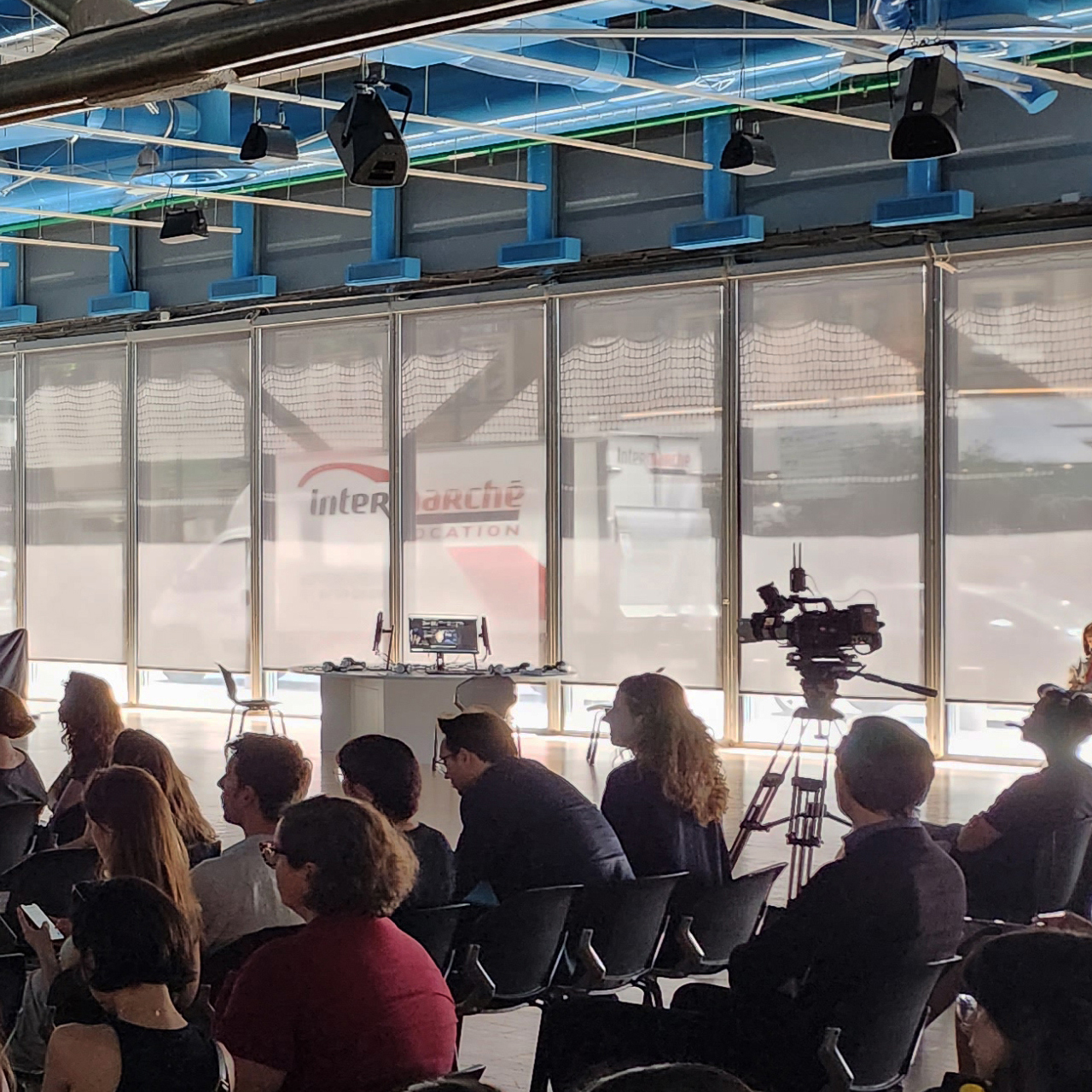
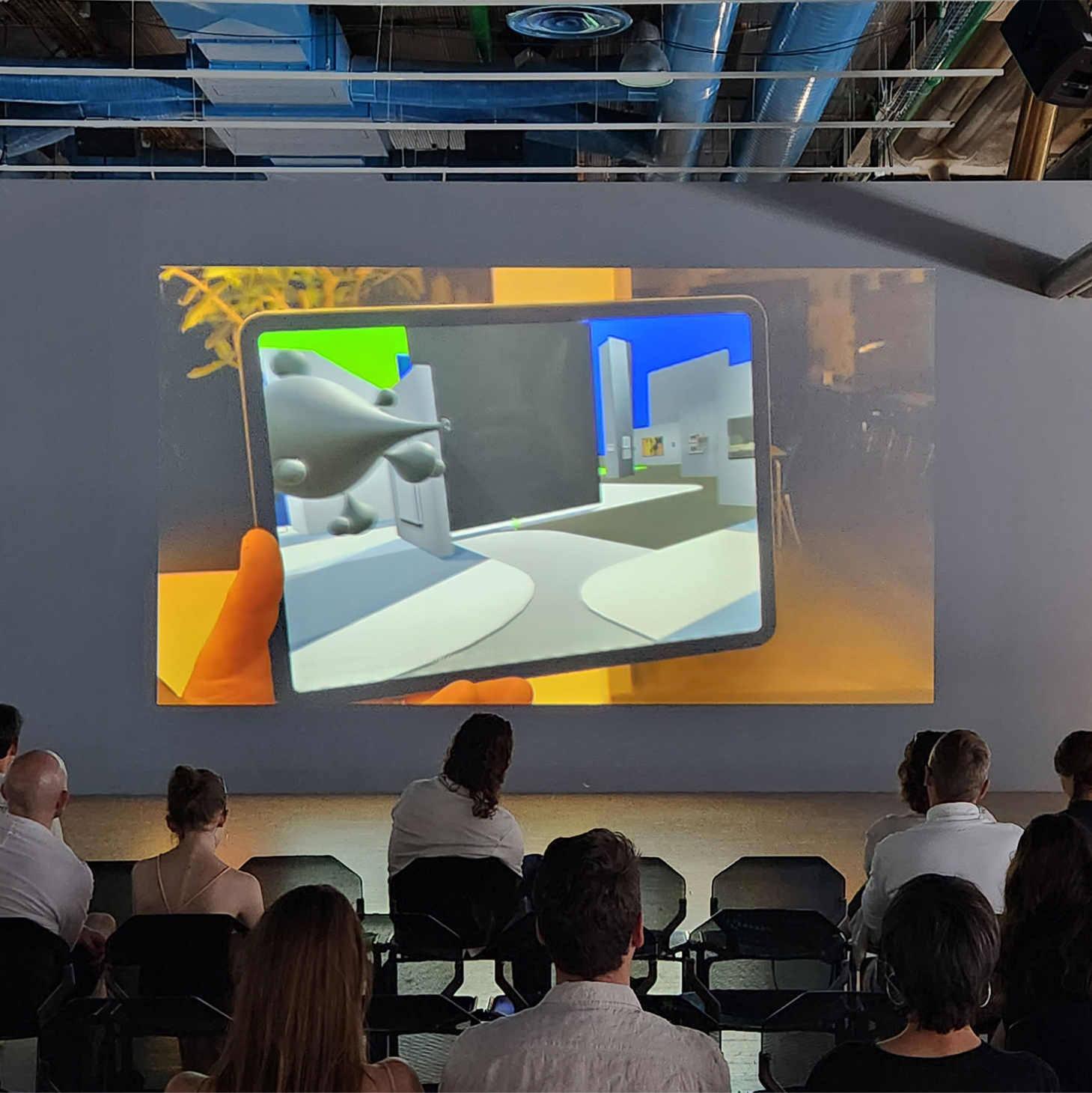
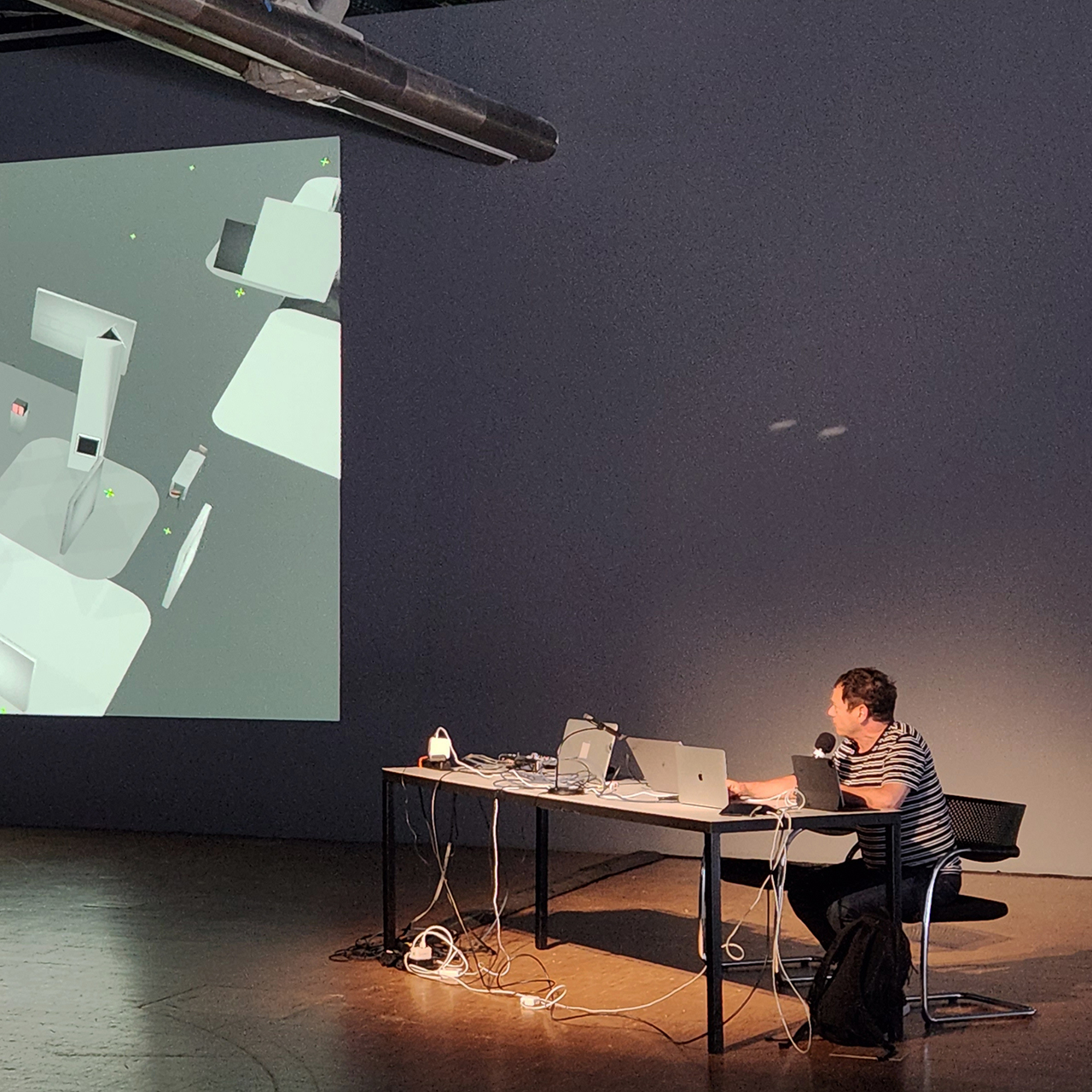
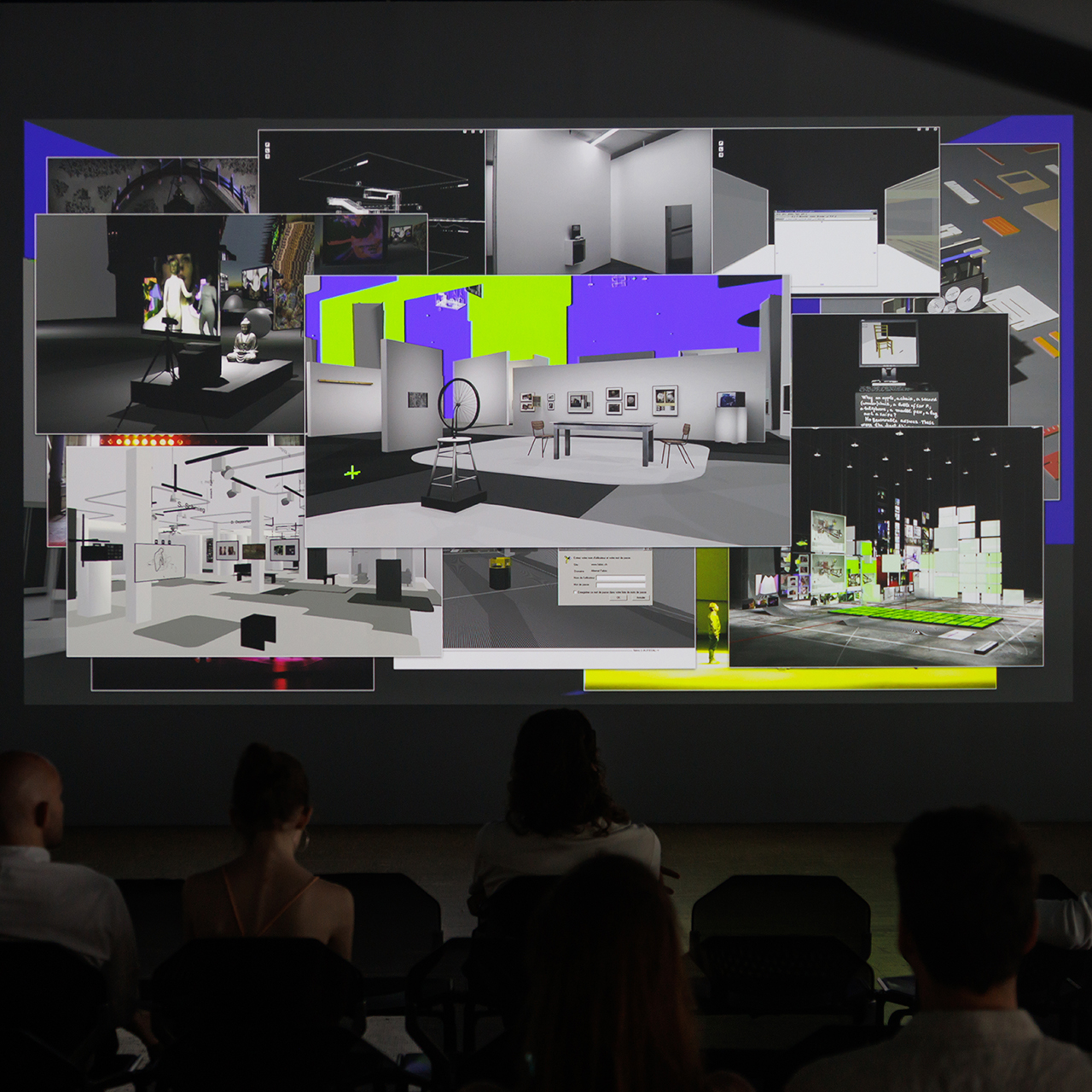
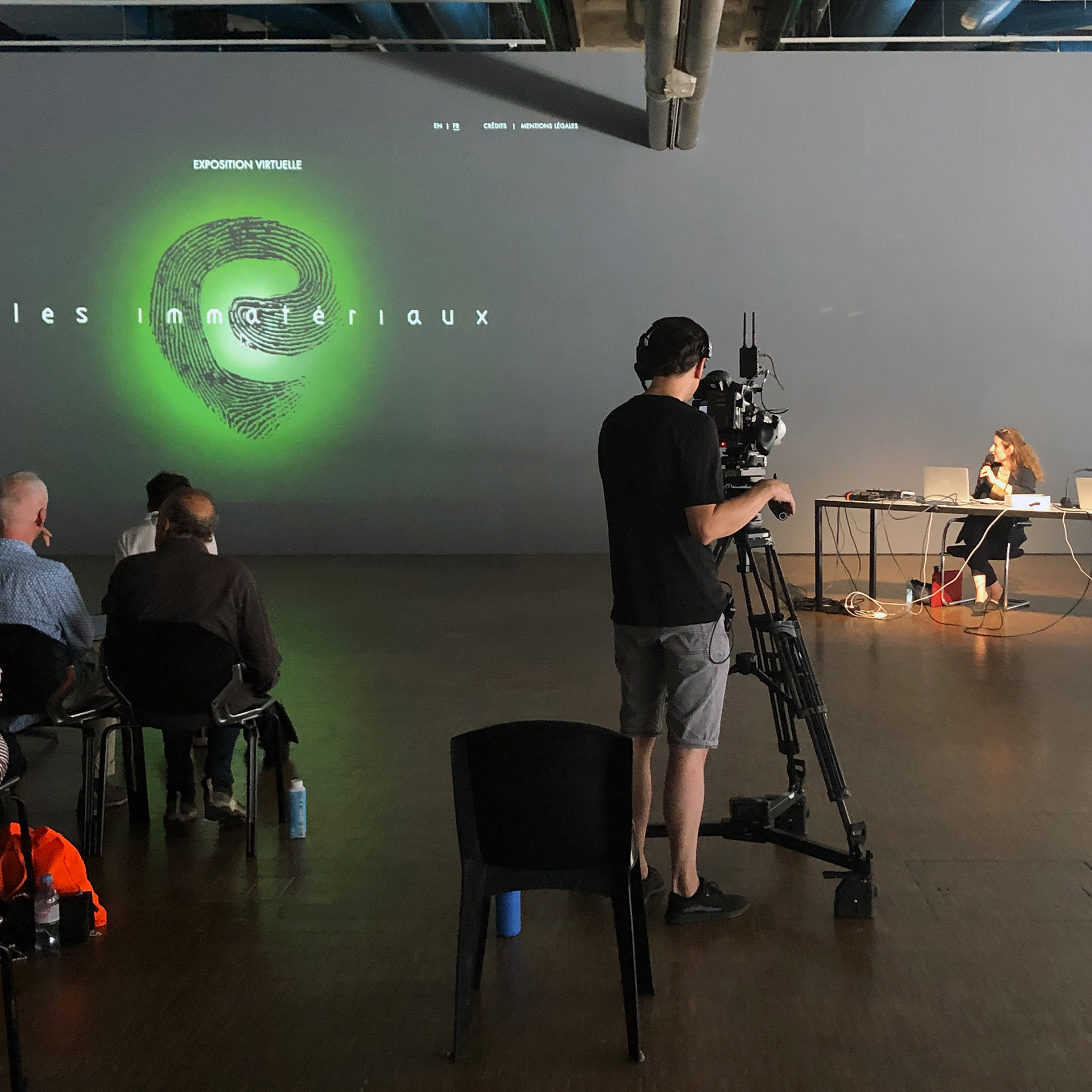
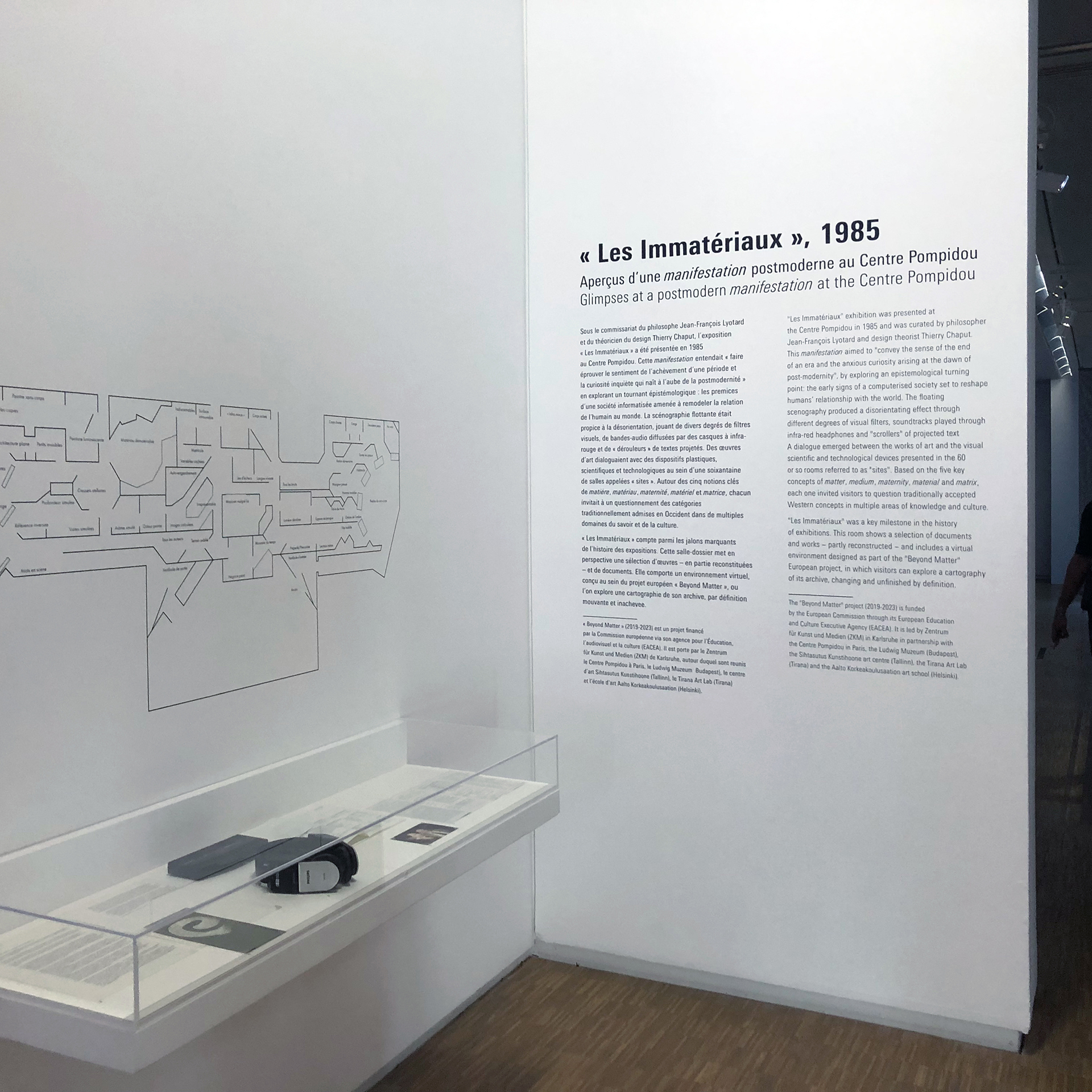
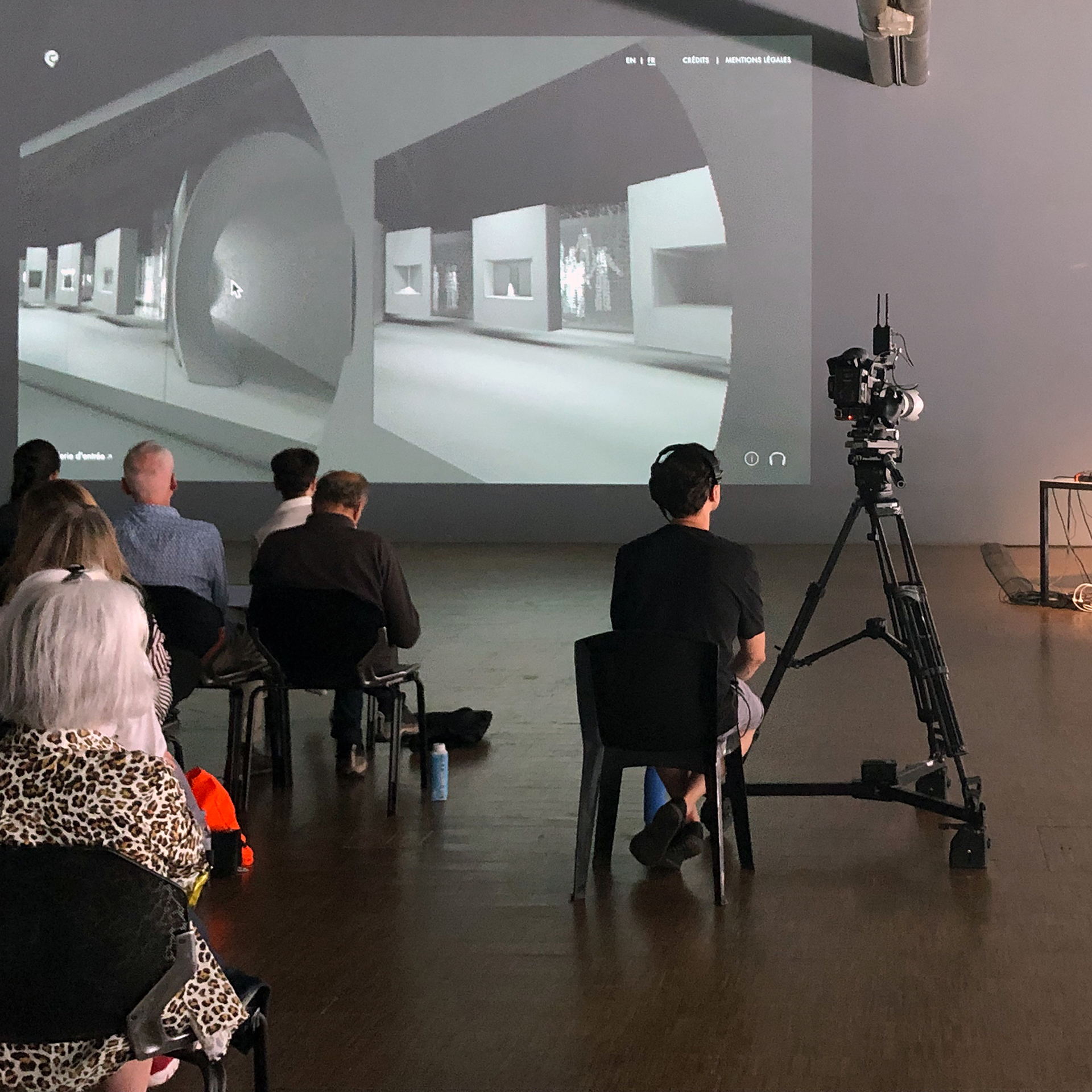
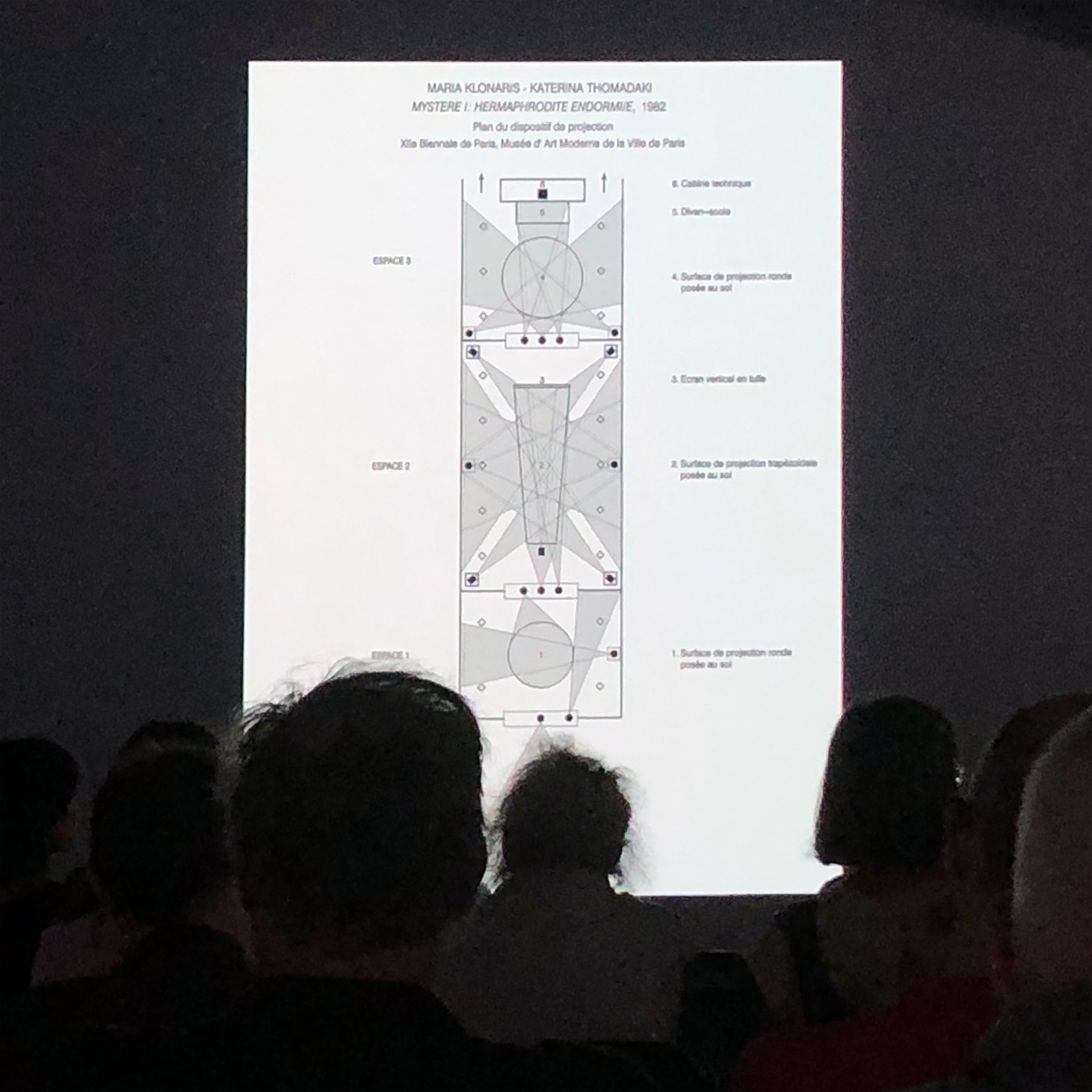
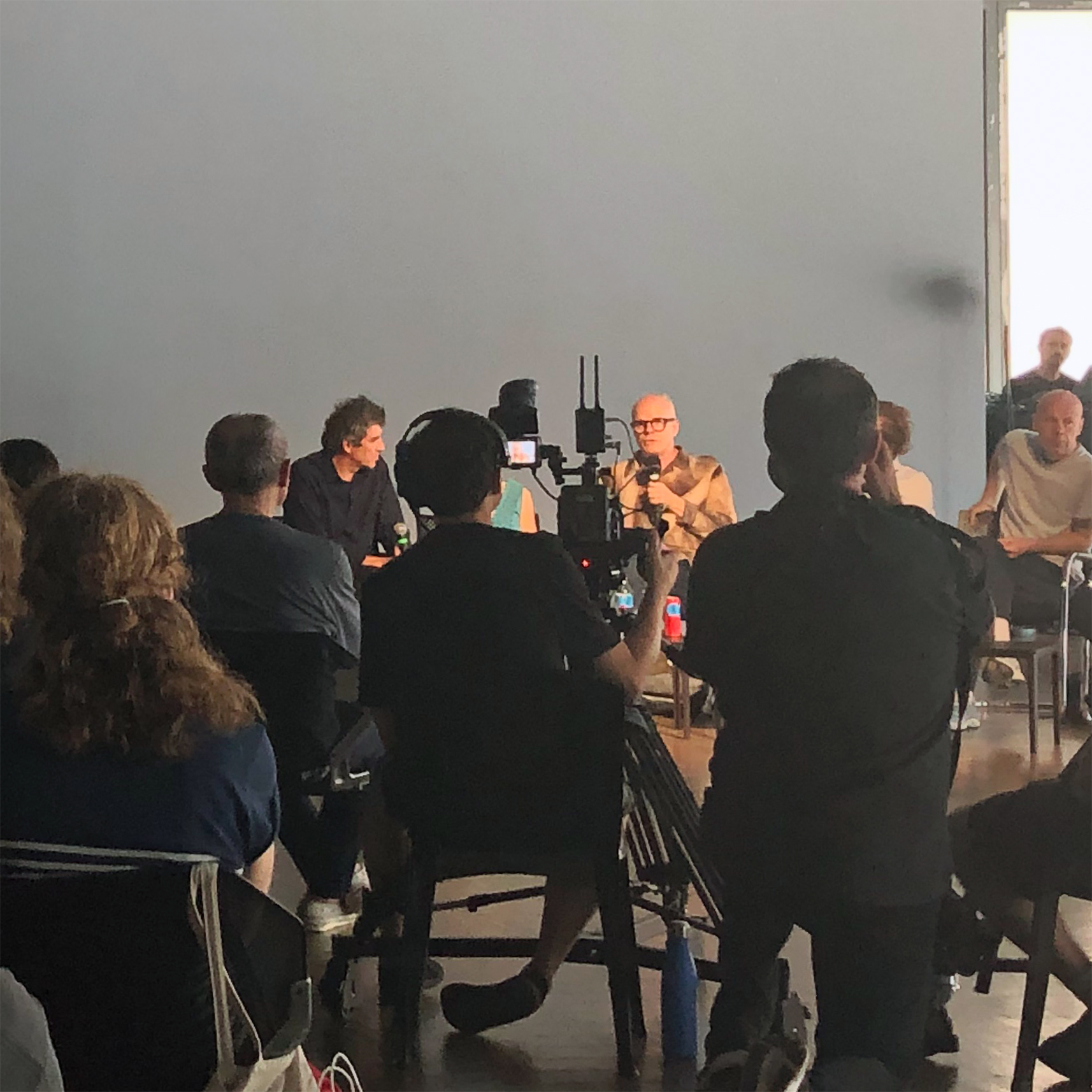
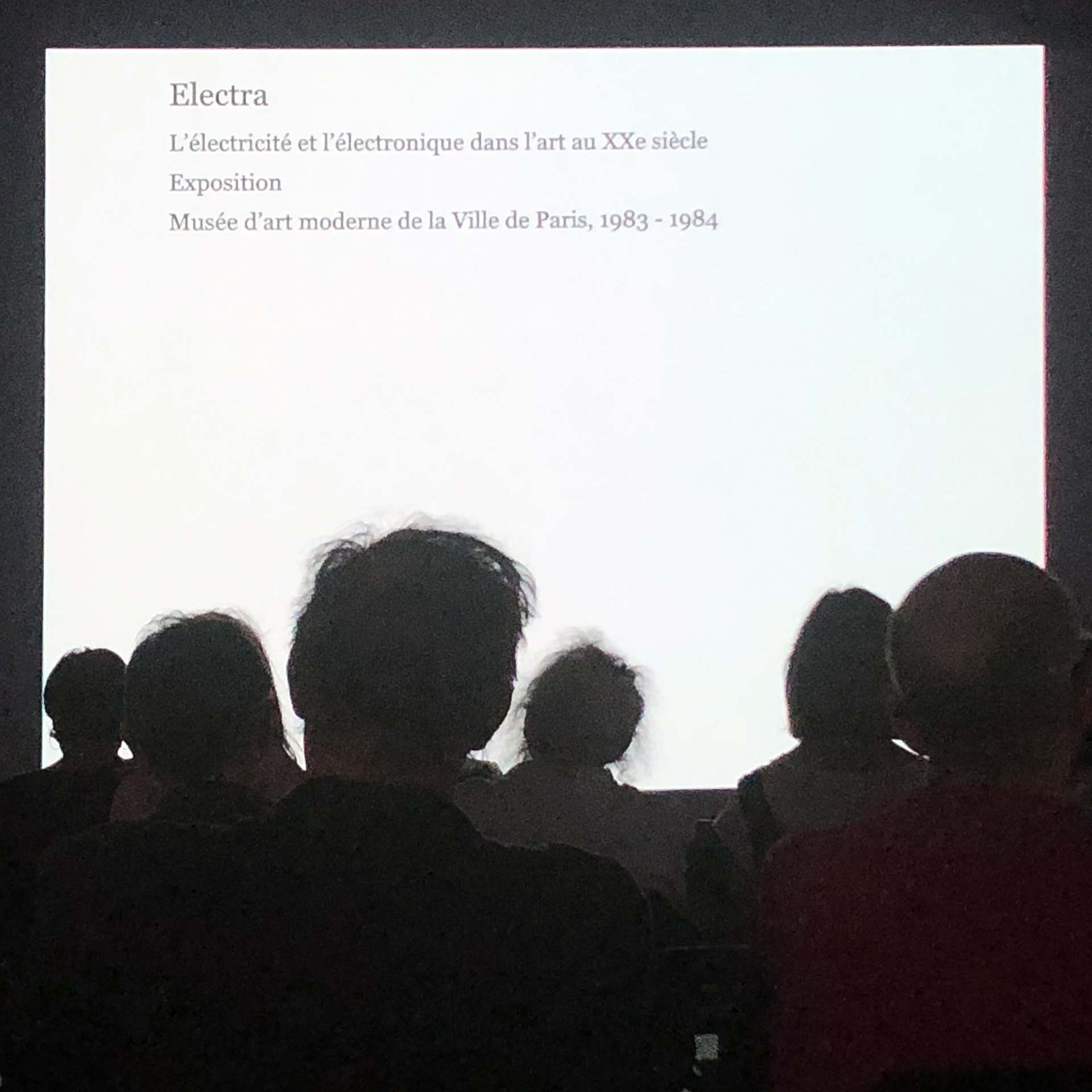
Via Centre Pompidou
-----
Beyond Matter / Par-delà la matière
Moviment, chapter 9
Sat 8 – Sun 9 July 2023

Combining technology and memory, the penultimate chapter of Moviment looks back at two major cultural events in the world of art and music, and the ways in which they can be perpetuated, revived or experienced beyond their materiality and topicality.
In partnership with LUMA Foundation
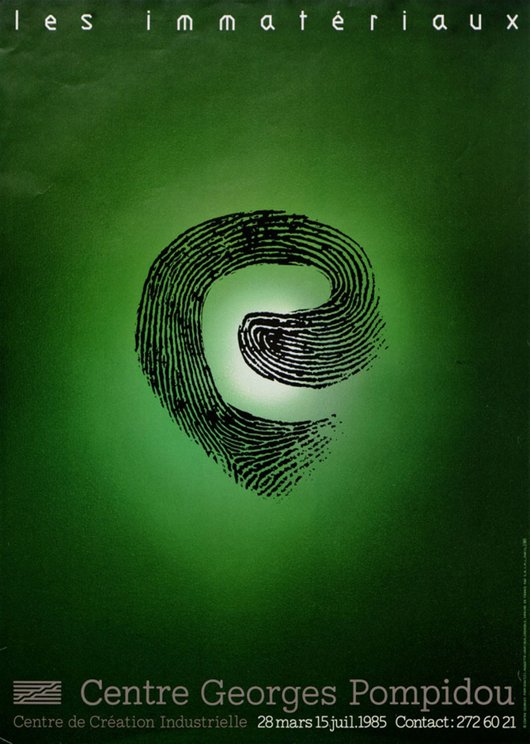
Affiche de l’exposition "Les Immatériaux", 1985 – © Centre Pompidou. Conception graphique : Grafibus.
Retour sur « Les Immatériaux »
Arts plastiques, Nouveaux médias Exposition, rencontres
Organisé par les commissaires Jean-François Lyotard et Thierry Chaput en 1985, « Les Immatériaux » était un essai aux fondements philosophiques adoptant l’exposition comme média ou interface. En faisant dialoguer œuvres d’art, technologies et documents scientifiques, les commissaires interrogeaient la condition humaine à l’ère des nouvelles technologies, dans différents domaines de la vie physique et psychique. La scénographie, particulièrement novatrice, privilégiait la désorientation, la stimulation de tous les sens et l’interactivité. Les visiteurs, dont le parcours n’était pas contraint mais « induit » par des écrans suspendus à l’opacité variable, étaient munis d’un casque diffusant une bande sonore variant au gré de leur déambulation dans la soixantaine de sites et les vingt-six zones audio de l’exposition.
Cette exposition historique a récemment fait l’objet d’une reconstitution virtuelle dans le cadre du projet de recherche « Beyond Matter ».
Exposition en continu, samedi 8 juillet 2023
« Beyond Matter »
Financé par la Commission européenne, le projet de recherche « Beyond Matter: Cultural Heritage on the Verge of Virtual Reality » vise à développer des outils technologiques et théoriques pour la reconstitution virtuelle d’expositions historiques et la documentation d’expositions en cours. Les recherches menées dans le cadre de ce projet ont notamment porté sur deux expositions pionnières : « Iconoclash » (4 mai–1er septembre 2002, ZKM) et « Les Immatériaux » (28 mars–15 juillet 1985, Centre Pompidou).
Lívia Nolasco-Rózsás et Marianne Schädler du Zentrum für Kunst und Medien de Karlsruhe (ZKM) présenteront la publication conclusive du projet européen.
Les artistes Jeremy Bailey, Damjanski, fabric | ch (Patrick Keller, Christian Babski, Christophe Guignard), Geraldine Juárez (en visioconférence), Carolyn Kirschner et Anne Le Troter présenteront ensuite les œuvres qu’ils et elles ont pu concevoir dans le cadre de l’exposition « Matter, Non-Matter, Anti-Matter » (3 décembre 2022–23 avril 2023, ZKM), restituant une partie des résultats du projet « Beyond Matter ».
Samedi 8 juillet 2023, 13h30–16h
« Les Immatériaux » : Artistes et historiens en conversation
Le chercheur Andreas Broeckmann, ainsi que les artistes Katerina Thomadaki, Jean-Louis Boissier et Jean-Claude Fall reviennent sur « Les Immatériaux », exposition pionnière à laquelle ils ont participé.
Séance modérée par Marcella Lista, Philippe Bettinelli et Marie Vicet.
Samedi 8 juillet 2023, 16h-18h

Maria Klonaris, Katerina Thomadaki, "Orlando-Hermaphrodite II", 1985, photographies noir et blanc sur panneau.
Courtesy Katerina Thomadaki.
Après « Les Immatériaux »
Projet porté par le curateur Hans Ulrich Obrist et l’artiste Philippe Parreno avec le soutien de LUMA Foundation, « Résistances » fait écho à l’exposition « Les Immatériaux » imaginée par Jean-François Lyotard. Resté inachevé, ce projet se trouve tout à la fois continué et réimaginé à travers des rencontres et la production de « films de pensée ».
Samedi 8 juillet 2023, 18h–19h30
La conversation se déroulera en français et en anglais, suivie d’une projection des « films de pensée ».
Films de pensée :
Produits et commandés par LUMA Foundation
Courtesy Maja Hoffmann / Luma Foundation Collection
- Être Résistances d’Albert Serra (2016, 198 min.)
« Être Résistances est un film qui résiste à en être un, c'est-à-dire qu'il résiste à la conscience et au langage cinématographique. C'est un film qui traite de théorie, de corps, de bruits, de discours, d'images, de jeu et d'ironie. C'est un film inspiré par son propre sujet invisible : l'exposition inexistante de Lyotard qui devrait résister à la communication. Le film est finalement cette exposition devenue réalité, mais comme un mirage et comme une illusion. » Albert Serra.
Séances, samedi 8 juillet 2023, à 13h30 et 17h30
Introduction par Albert Serra à 17h30
Cinéma 2, niveau –1
- The Rare Event de Ben Rivers et Ben Russell (2017, 48 min.) sous-titrage en français
Tourné dans un studio d'enregistrement parisien au plancher de bois grinçant, lors d'un « forum des idées » inaugural de trois jours consacré aux multiples possibilités de la Résistance – titre de l'exposition de Jean-François Lyotard qui devait faire suite à son exposition « Les Immatériaux » de 1985 –, les collaborateurs occasionnels Ben Rivers et Ben Russell (avec la contribution de l'artiste américain Peter Burr) ont produit ce qui apparaît d'abord comme un document structuraliste d'une discussion philosophique performée qui se transforme lentement en The Rare Event, un portail qui réunit toutes les dimensions en une seule.
- Resistances de Rachel Rose (2017-2019, 20 min.) VO en anglais
Ce court-métrage documente la deuxième rencontre sur les « Résistances » qui a eu lieu en février 2017 à New York, offrant ainsi un aperçu des conversations et des réflexions qui se sont déployées au cours de ce « forum des idées » organisé par Maja Hoffmann. Parmi les intervenants figurent Tyrone Hayes, Isabelle Thomas Fogiel, Reza Negarestani, Ariana Reines, Fred Moten, et de nombreux autres invités.
Projection, samedi 8 juillet 2023, à 19h30
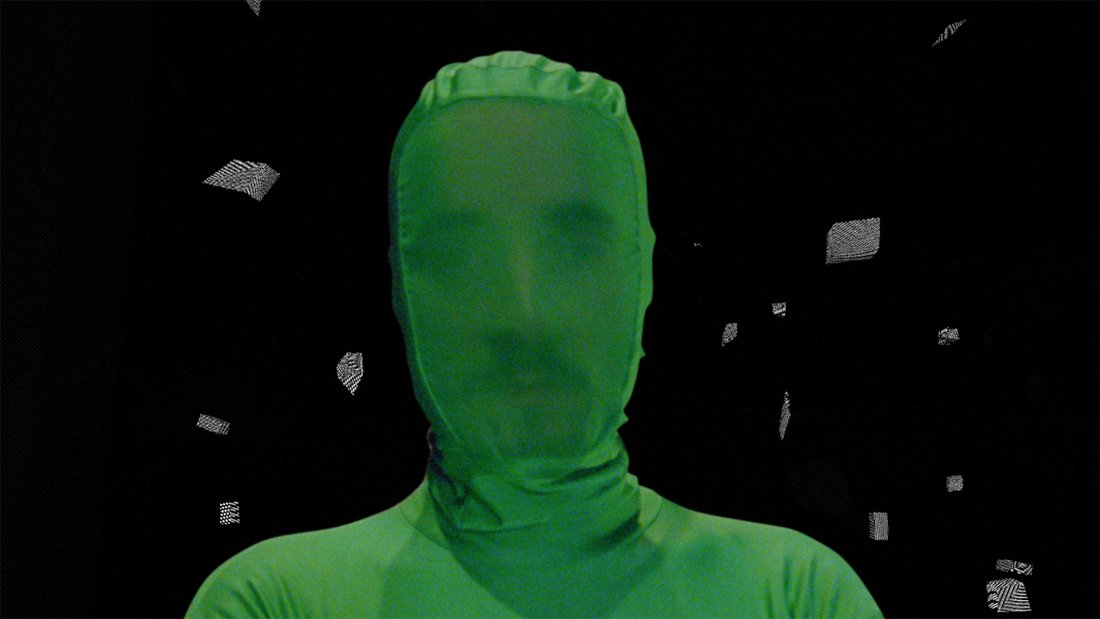
Plan fixe du film "THE RARE EVENT" de Ben Rivers et Ben Russell.
Courtesy Maja Hoffmann / Luma Foundation Collection.
En lien avec la présentation temporaire au Musée, niveau 4, Espace de consultation des collections vidéos, films, sons et œuvres numériques :
« Les Immatériaux » (1985). Aperçus d'une manifestation postmoderne au Centre Pompidou. Du 5 juillet au 30 octobre 2023
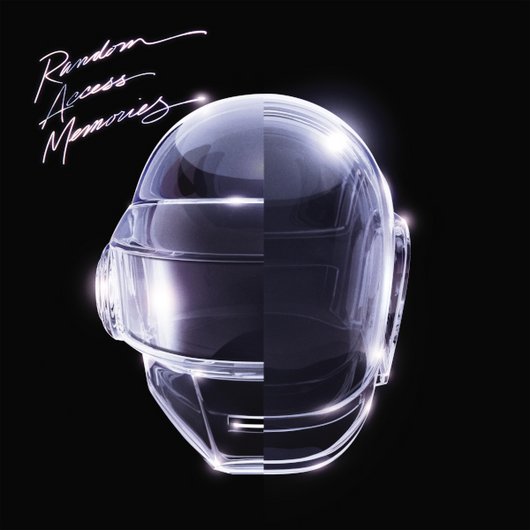
Couverture de l'album Daft Punk, "Random Access Memories" © Zaina
Daft Punk, Random Access Memories
Session d’écoute avec Sonorium
Musique Session d'écoute, rencontre
5 Grammy Awards et un triomphe instantané, un tube planétaire ("Get Lucky"), une production incroyable de précision et des collaborations prestigieuses (Pharrell Williams, Julian Casablancas, Panda Bear, Giorgio Moroder…), Random Access Memories, le dernier album de Daft Punk, a marqué les esprits et installé le duo comme une figure majeure de la pop contemporaine.
À l'occasion de l'édition 10e anniversaire de l'album culte le 12 mai dernier, le Centre Pompidou et Sonorium vous invitent à une session d'écoute de l'album en intégralité, dans des conditions exceptionnelles grâce à une installation sonore immersive réalisée par l’Ircam et une nouvelle technologie immersive développée par sa filiale Ircam Amplify.
Dimanche 9 juillet 2023 – gratuit sur réservation
Sessions précédées d'une introduction par Éric Jean-Jean et suivies d'une discussion avec le public
Day-by-day program
Saturday, 8 July 2023
|
Continuous 11am-1pm |
Performance Christian Falsnaes, First (2016) |
|
Exhibition Reconstitution virtuelle de l'exposition « Les Immatériaux » |
|
| 1:30pm-2pm |
Meeting « Beyond Matter » Présentation de la publication conclusive du projet européen « Beyond Matter: Cultural Heritage on the Verge of Virtual Reality » |
| 1:30pm-5pm |
Screening Après « Les Immatériaux » : Films de pensée Être Résistances d’Albert Serra (2016, 198 min.) |
| 2pm-4pm |
Meeting « Beyond Matter » Présentation d'œuvres conçues dans le cadre de l'exposition « Matter, Non-matter, Anti-Matter » Avec les artistes Jeremy Bailey, Damjanski, fabric | ch (Patrick Keller, Christian Babski, Christophe Guignard), Geraldine Juárez (en visioconférence), Carolyn Kirschner et Anne Le Troter |
| 4pm-6pm |
Meeting « Les Immatériaux » : Artistes et historiens en conversation Avec Andreas Broeckmann, Katerina Thomadaki, Jean-Louis Boissier et Jean-Claude Fall Modérée par Marcella Lista, Philippe Bettinelli et Marie Vicet (Centre Pompidou) |
| 5:30pm-9pm |
Screening Après « Les Immatériaux » : Films de pensée Être Résistances d’Albert Serra (2016, 198 min.) En présence du cinéaste |
| 6pm-7:30pm |
Meeting Après « Les Immatériaux » : Rencontre en partenariat avec LUMA Foundation Avec Hans Ulrich Obrist, Philippe Parreno, Daniel Birnbaum, Anna Longo, Maja Hoffmann (en visioconférence) et Albert Serra |
| 7:30pm-9pm |
>Screening Après « Les Immatériaux » : Films de pensée
|
Sunday, 9 July 2023
|
Reconstitution virtuelle de l'exposition « Les Immatériaux »
|
Closing of the gallery 3 at the beginning of the day |
|
Continuous 3pm-9pm |
Performance Christian Falsnaes, First (2016) |
|
4pm-6pm 6:30pm-8:30pm |
Listening session, meeting Daft Punk, Random Access memories Introduction par Éric Jean-Jean Session d'écoute Discussion avec le public |
Guests
|
Hans Ulrich ObristVisual arts
|
Philippe ParrenoVisual arts
|
|
Jean-Louis BoissierNew media
|
Katerina ThomadakiNew media
|
Also in the presence of:
Jeremy Bailey, Daniel Birnbaum, Andreas Broeckmann, Damjanski, fabric | ch (Patrick Keller, Christian Babski, Christophe Guignard), Jean-Claude Fall, Maja Hoffmann, Éric Jean-Jean, Geraldine Juárez, Carolyn Kirschner, Anna Longo, Marianne Schädler, Albert Serra, Anne Le Troter.
Wednesday, March 22. 2023
Matter. Non-Matter. Anti-Matter @ZKM – Webinar on the digital museum | #fabricch
Note: fabric | ch is taking part next week in this webinar about digital museums, organized by ZKM. Participants include members from ZKM Hertz-Lab, Ars Electronica Futurelab, CCCB in Barcelona, Aalto University and Futurium in Berlin.
Via ZKM | Karlsruhe (research project & exhibition: Beyond Matter)
-----
Monday, March 13. 2023
Atomized (re-)Staging short video documentation | #fabricch #digital #hybrid #exhibition
Note: a brief video documentation about one of fabric | ch's latest project – Atomized (Re)Staging – that was exhibited at ZKM during Matter. Non-Matter. Anti-Matter.
The exhibition was curated by Lívía Nolasco-Roszás and Felix Koberstein and took place ibn the context of the European research project Beyond Matter.
![]()
-----
Wednesday, November 30. 2022
Past exhibitions as Digital Experiences @ZKM, fabric | ch | #digital #exhibition #experimentation
Note:
The exhibition related to the project and European research Beyond Matter - Past Exhibitions as Digital Experiences will open next week at ZKM, with the digital versions (or should I rather say "versioning"?) of two past and renowned exhibitions: Iconoclash, at ZKM in 2002 (with Bruno Latour among the multiple curators) and Les Immateriaux, at Beaubourg in 1985 (in this case with Jean-François Lyotard, not so long after the release of his Postmodern Condition). An unusual combination from two different times and perspectives.
The title of the exhibition will be Matter. Non-Matter. Anti-Matter, with an amazing contemporary and historic lineup of works and artists, as well as documentation material from both past shows.
Working with digitized variants of iconic artworks from these past exhibitions (digitization work under the supervision of Matthias Heckel), fabric | ch has been invited by Livia Nolasco-Roszas, ZKM curator and head of the research, to present its own digital take in the form of a combination on these two historic shows, and by using the digital models produced by their research team and made available.

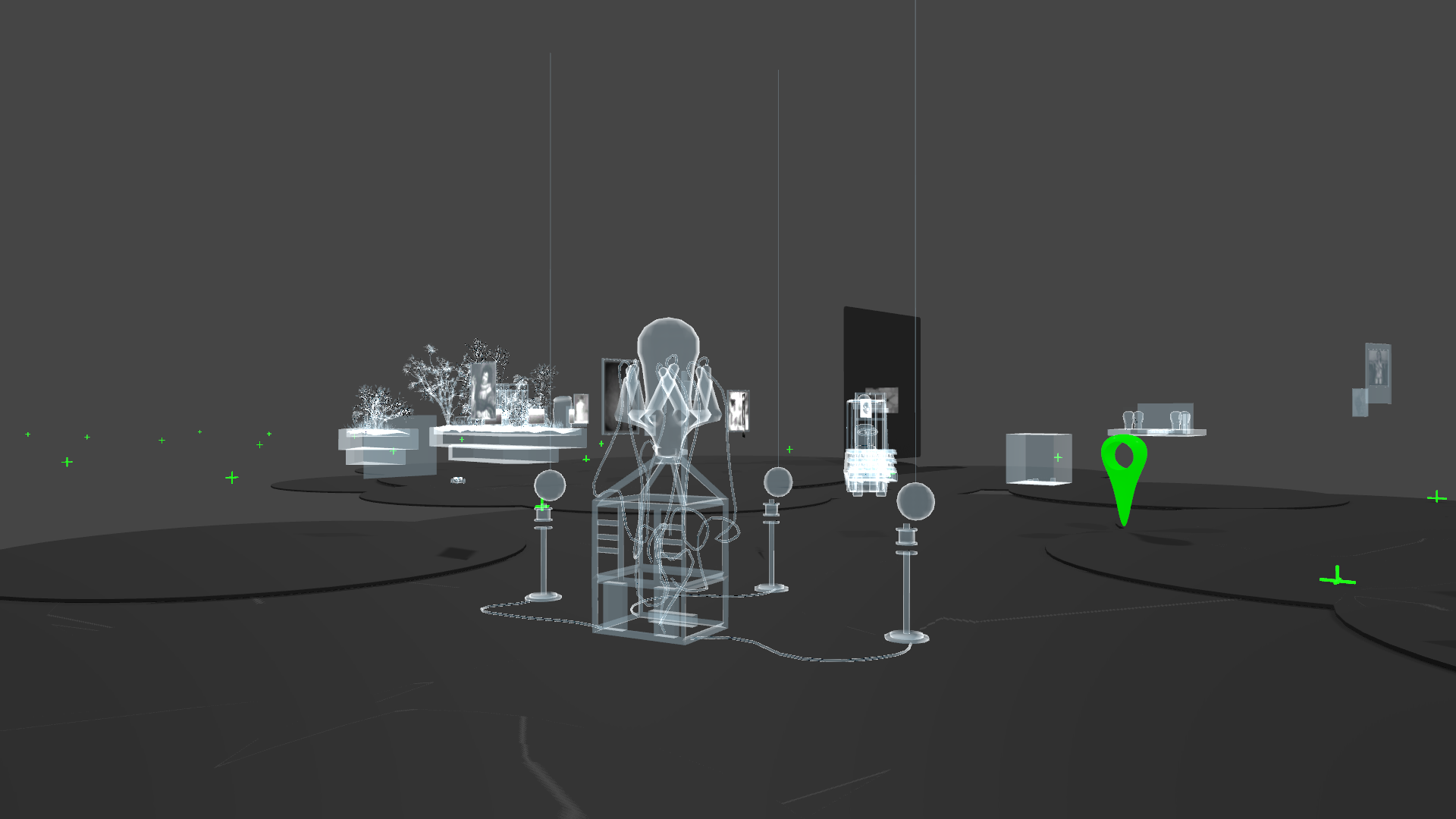
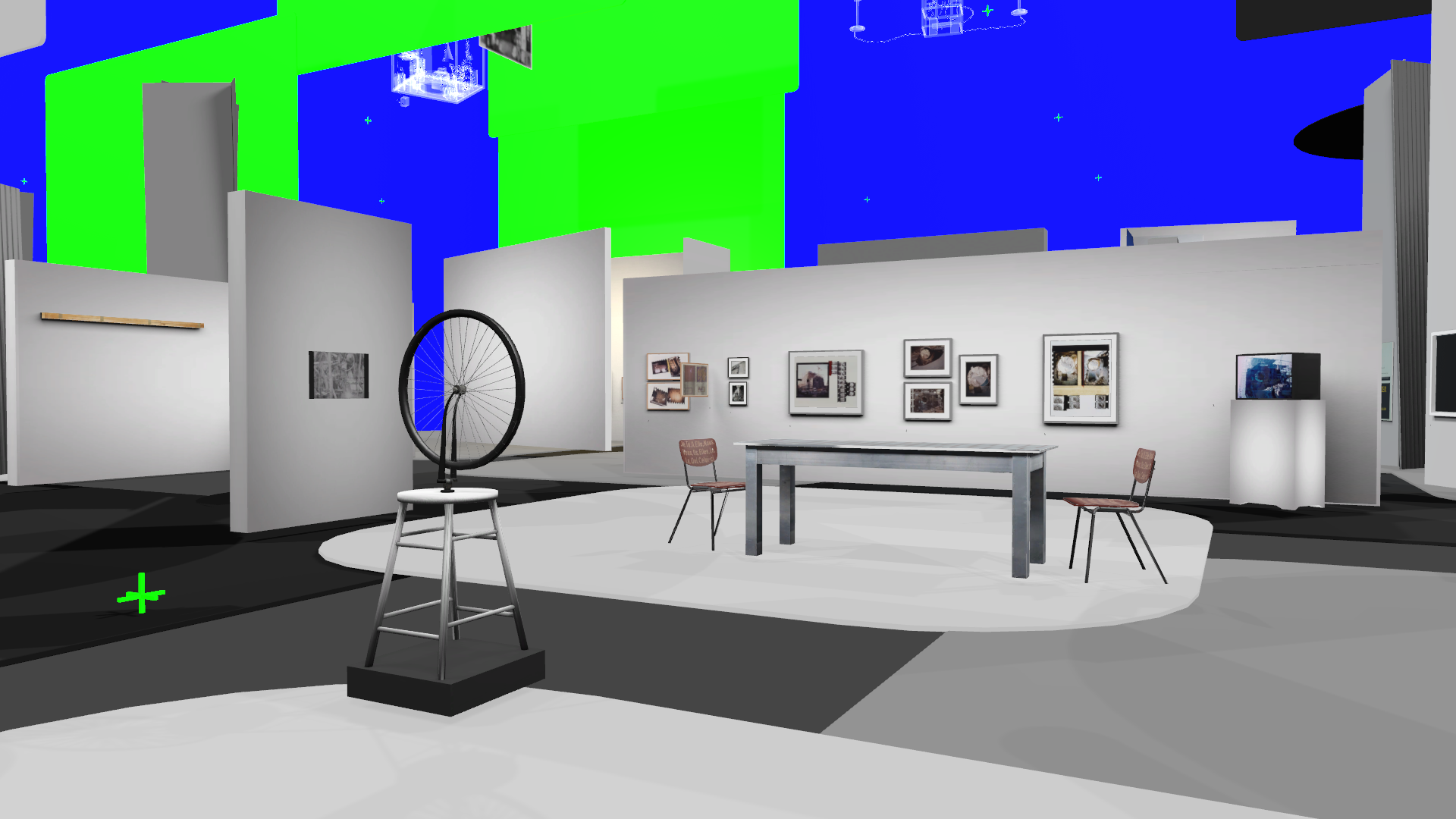
The result, a new fabric | ch project entitled Atomized (re-)Staging, will be presented at the ZKM in Karlsruhe from this Saturday on (03.12.2022 - 23.04.2023).
Via ZKM
-----

Opening: Matter. Non-Matter. Anti-Matter.
© ZKM | Center for Art and Media Karlsruhe, Visual: AKU Collective / Mirjam Reili
Past exhibitions as Digital Experiences
Fri, December 02, 2022 7 pm CET, Opening
---
Free entry
---
When past exhibitions come to life digitally, the past becomes a virtual experience. What this novel experience can look like in concrete terms is shown by the exhibition »Matter. Non-Matter. Anti-Matter«.
As part of the project »Beyond Matter. Cultural Heritage on the Verge of Virtual Reality«, the ZKM | Karlsruhe and the Centre Pompidou, Paris, use the case studies »Les Immatériaux« (Centre Pompidou, 1985) and »Iconoclash« (ZKM | Karlsruhe, 2002) to investigate the possibility of reviving exhibitions through experiential methods of digital and spatial modeling.
The digital model as an interactive presentation of exhibition concepts is a novel approach to exploring exhibition history, curatorial methods, and representation and mediation. The goal is not to create »digital twins«, that is, virtual copies of past assemblages of artifacts and their surrounding architecture, but to provide an independent sensory experience.
On view will be digital models of past exhibitions, artworks and artifacts from those exhibitions, and accompanying contemporary commentary integrated via augmented reality. The exhibition will be accompanied by a conference on virtualizing exhibition histories.
The exhibition will be accompanied by numerous events, such as specialist workshops, webinars, online and offline guided tours, and a conference.
---
Program
7 – 7:30 p.m. Media Theater
Short lectures by
Sybille Krämer, Professor (emer.) at the Free University of Berlin
Siegfried Zielinski, media theorist with a focus on archaeology and variantology of arts and media, curator, author
Moderation: Lívia Nolasco-Rózsás, curator
7:30 – 8:15 p.m. Media Theater
Welcome
Olga Sismanidi, Representative Creative Europe Program of the European Commission (EACEA)
Arne Braun, State Secretary in the Ministry of Science, Research and the Arts of Baden-Württemberg
Frank Mentrup, Lord Mayor of the City of Karlsruhe
Peter Weibel, Director of the ZKM | Karlsruhe
Xavier Rey, Director of the Centre Pompidou, Paris
8:15 – 8:30 p.m. Improvisation on the piano
Hymn Controversy by Bardo Henning
8:30 p.m.
Curator guided tour of the exhibition
---
The exhibition will be open from 8 to 10 p.m.
The mint Café is also looking forward to your visit.
---
Matter. Non-Matter. Anti-Matter.
Past Exhibitions as Digital Experiences.
Sat, December 03, 2022 – Sun, April 23, 2023
The EU project »Beyond Matter: Cultural Heritage on the Verge of Virtual Reality« researches ways to reexperience past exhibitions using digital and spatial modeling methods. The exhibition »Matter. Non-Matter. Anti-Matter.« presents the current state of the research project at ZKM | Karlsruhe.
At the core of the event is the digital revival of the iconic exhibitions »Les Immatériaux« of the Centre Pompidou Paris in 1985 and »Iconoclash: Beyond the Image Wars in Science, Religion, and Art« of the ZKM | Karlsruhe in 2002.
Based on the case studies of »Les Immatériaux« (Centre Pompidou, 1985) and »Iconoclash: Beyond the Image Wars in Science, Religion, and Art« (ZKM, 2002), ZKM | Karlsruhe and the Centre Pompidou Paris investigate possibilities of reviving exhibitions through experiential methods of digital and spatial modeling. Central to this is also the question of the particular materiality of the digital.
At the heart of the Paris exhibition »Les Immatériaux« in the mid-1980s was the question of what impact new technologies and materials could have on artistic practice. When philosopher Jean-François Lyotard joined as cocurator, the project's focus eventually shifted to exploring the changes in the postmodern world that were driven by a flood of new technologies.
The exhibition »Iconoclash« at ZKM | Karlsruhe focused on the theme of representation and its multiple forms of expression, as well as the social turbulence it generates. As emphasized by curators Bruno Latour and Peter Weibel, the exhibition was not intended to be iconoclastic in its approach, but rather to present a synopsis of scholarly exhibits, documents, and artworks about iconoclasms – a thought experiment that took the form of an exhibition – a so-called »thought exhibition.«
»Matter. Non-Matter. Anti-Matter.« now presents in the 21st century the digital models of the two projects on the Immaterial Display, hardware that has been specially developed for exploring virtual exhibitions. On view are artworks and artifacts from the past exhibitions, as well as contemporary reflections and artworks created or expanded for this exhibition. These include works by Jeremy Bailey, damjanski, fabric|ch, Geraldine Juárez, Carolyn Kirschner, and Anne Le Troter that echo the 3D models of the two landmark exhibitions. They bear witness to the current digitization trend in the production, collection, and presentation of art.
Case studies and examples of the application of digital curatorial reconstruction techniques that were created as part of the Beyond Matter project complement the presentation.
The exhibition »Matter. Non-Matter. Anti-Matter.« is accompanied by an extensive program of events: A webinar series aimed at museum professionals and cultural practitioners will present examples of work in digital or hybrid museums; two workshops, coorganized with Andreas Broeckmann from Leuphana University Lüneburg, will focus on interdisciplinary curating and methods for researching historical exhibitions; workshops on »Performance-Oriented Design Methods for Audience Studies and Exhibition Evaluation« (PORe) will be held by Lily Díaz-Kommonen and Cvijeta Miljak from Aalto University.
After the exhibition ends at the ZKM, a new edition of »Matter. Non-Matter. Anti-Matter.« will be on view at the Centre Pompidou in Paris from May to July 2023.
>>>
Artists
Josef Albers, Giovanni Anselmo, Arman, Art & Language, Jeremy Bailey, Fiona Banner, DiMoDa featuring Banz & Bowinkel, Christiane Paul, Tamiko Thiel, Ricardo Miranda Zúñiga, Samuel Bianchini, Bio Design Lab (HfG Karlsruhe), Jean-Louis Boissier & Liliane Terrier, John Cage, Jacques-Élie Chabert & Camille Philibert, damjanski, Annet Dekker & Marialaura Ghidini & Gaia Tedone, Marcel Duchamp, fabric | ch, Eric J. Heller, Prof. Dr. Kai-Uwe Hemken (Art Studies Kunsthochschule Kassel / University of Kassel), Joasia Krysa, Leonardo Impett, Eva Cetinić, MetaObjects, Sui, Michel Jaffrennou, Geraldine Juárez, Martin Kippenberger, Carolyn Kirschner, Maria Klonaris & Katerina Thomadaki, Joseph Kosuth, Denis Laborde, Mark Lewis & Laura Mulvey, Kasimir Malevich, Pietro Manzoni, Gordon Matta-Clark, Peo Olsson, Katarina Sjögren, Jonas Williamsson, Roman Opalka, Nam June Paik, Readymades belong to everyone®, Jeffrey Shaw, Annegret Soltau, Daniel Soutif & Paule Zajderman, Klaus Staeck, Anne Le Troter, Manfred Wolff-Plottegg, Erwin Wurm
-
Curator
Livia Nolasco-RózsásCuratorial team
Felix Koberstein (ZKM)
Moritz Konrad (ZKM)
Marcella Lista (Centre Pompidou, Paris)
Philippe Bettinelli (Centre Pompidou, Paris)
Julie Champion (Centre Pompidou, Paris)Beyond Matter project team at ZKM
Marianne Schädler (managing editor)
Aurora Bertolli (communication)Exhibition team
Matthias Gommel (Scenography)
Janine Burger (Participation)
Thomas Schwab (Technical project management)Graphic design
AKU.coMuseum and Exhibition Technology
Martin Mangold - Organization / Institution
- Initiated by the ZKM | Center for Art and Media Karlsruhe and the Centre Pompidou, Paris, in collaboration with the Aalto University, Espoo, the Tallinn Art Hall, and the Tirana Art Lab.
>>>
Further locations and dates:
| Mar 14, 2022 – Mar 29, 2022 | Väre, Aalto University, Espoo |
| Apr 20, 2022 – Apr 25, 2022 | The Cube / Helsinki Central Library Oodi |
| Apr 25, 2022 – May 5, 2022 | Väre, Aalto University, Espoo |
| May 16, 2022 – May 22, 2022 | Design Museum Helsinki |
| June 25, 2022 – August 28, 2022 | Tirana Art Lab, Albanien |
| Dec 3, 2022 – Apr 23, 2023 | ZKM |
| Summer 2023 | Centre Pompidou, Paris |
---
Project
Cooperation partners
Supported by
Tuesday, September 21. 2021
"Essais climatiques" by P. Rahm, Ed. B2 (Paris, 2020) | #2ndaugmentation #essay #AR #VR
Note: it is with great pleasure and interest that I read recently one of Philippe Rahm's last publication, "Essais climatiques" (published in French, by Editions B2), which consists in fact in a collection of articles published in the past 10+ years in various magazines, journals and exhibition catalogs. It is certainly less developed than the even more recent book, "L'histoire naturelle de l'architecture" (ed. Pavillon de l'Arsenal, 2020), but nonetheless an excellent and brief introduction to his thinking and work.
Philippe Rahm's call for the "return" of an "objective architecture", climatic and free of narrative issues, is of great interest. Especially at a time when we need to reduce our CO2 emissions and will need to reach energy objectives of slenderness. The historical reading of the postmodern era (in architecture), in relation to oil, vaccines and antibiotics is also really valuable in this context, when we are all looking to move forward this time in cultural history.
I also had the good surprise, and joy, to see the text "L'âge de la deuxième augmentation" finally published! It was written by Philippe back in 2009 probably, about the works of fabric | ch at the time, when we were preparing a publication that finally never came out... Though this text will also be part of a monographic publication that is expected to be finalized and self-published in 2022.
Via fabric | ch
-----
Friday, August 28. 2020
"Data Materialization", N. Kane (V&A) in discussion with P. Keller (ECAL, fabric | ch), ECAL website (Lausanne, 2020) | #data #research
Note: the discussion about "Data Materialization" between Nathalie Kane (V&A Museum, London) and Patrick Keller (fabric | ch, ECAL / University of Art and Design Lausanne (HES-SO)), on the occasion of the ECAL Research Day, has been published on the dedicated website, along with other interesting talks.
-----
Via ECAL
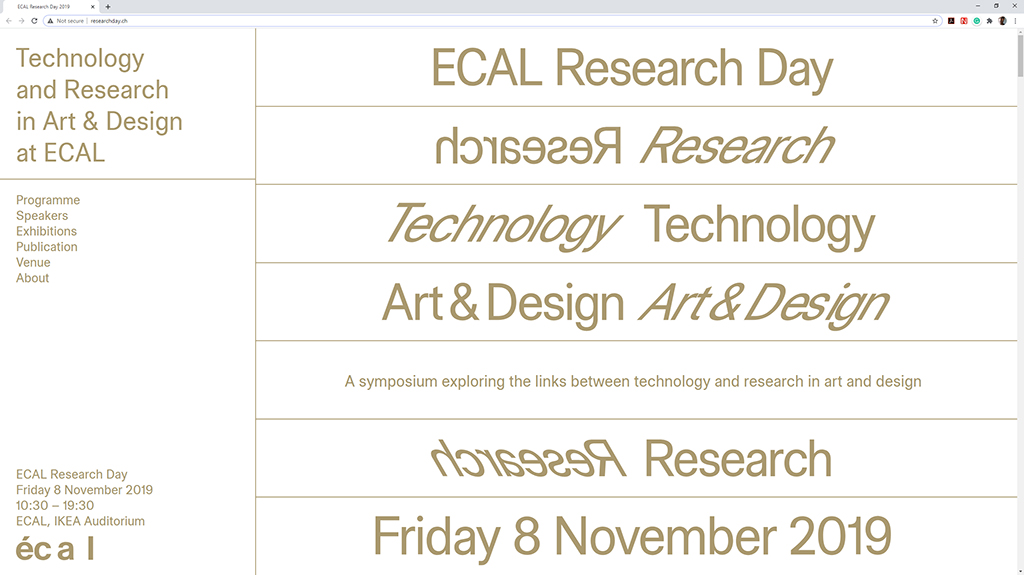
Research Day 2019 Natalie D. Kane from ECAL on Vimeo.
fabric | rblg
This blog is the survey website of fabric | ch - studio for architecture, interaction and research.
We curate and reblog articles, researches, writings, exhibitions and projects that we notice and find interesting during our everyday practice and readings.
Most articles concern the intertwined fields of architecture, territory, art, interaction design, thinking and science. From time to time, we also publish documentation about our own work and research, immersed among these related resources and inspirations.
This website is used by fabric | ch as archive, references and resources. It is shared with all those interested in the same topics as we are, in the hope that they will also find valuable references and content in it.
Quicksearch
Categories
Calendar
|
|
July '25 | |||||
| Mon | Tue | Wed | Thu | Fri | Sat | Sun |
| 1 | 2 | 3 | 4 | 5 | 6 | |
| 7 | 8 | 9 | 10 | 11 | 12 | 13 |
| 14 | 15 | 16 | 17 | 18 | 19 | 20 |
| 21 | 22 | 23 | 24 | 25 | 26 | 27 |
| 28 | 29 | 30 | 31 | |||

